




APGFCU® is ready to help ourservicemen and servicewomen enjoy homeownership
We’relocal, experienced and will help youthrough the loan process. The benefitsofa VA loan withAPGFCU include:
•1 00% fina ncing –n od ow np ay men tr equir ed •Purchase and refinance options •Nomonthly mor tgage insurance requirement
VA loan programs areavailable to qualified veterans, reservists, active-duty service members and their eligible spouses.


















10 6Y EA RS LA TE R





Pr ou dp ar tn er sw it h









Ab er de en Pr ov in gG ro und

HA RF OR DC OU NT Y







DEPARTMENT OF ECONOMIC DEVELOPMENT
Ka re nH ol t, Di re ct or 220South Main Street, BelAir,MD2 1014
www.har fordcountymd.gov/OED oed@har fordcountymd.gov
410-638 -3059



home.army.mil/apg
Flickr: flickr.com/photos/usagapg/ Facebook: Facebook.com/APGMd Instagram: Aberdeen_Proving_Ground

APG Senior Commander
Maj. Gen. James D. Turinetti IV
APG Garrison Commander Col. Philip J. Mundweil
The Proof is collated, compiled, and edited by the U.S. Army Communications-Electronics Command’s G-9/Strategic Communications Team, the APG Garrison Public Affairs Team, and with the assistance of public affairs offices from tenant commands throughout APG, APG South, and Adelphi.
Regional President
Orestes Baez
Executive Editor
Eli Wohlenhaus ewohlenhaus@dcmilitary.com 240-801-2258
Account Executive
Ryan Ebaugh
David Murch
Jason O’Neill
Kim Spencer
Designer Steve Baird
The Proof magazine is an authorized publication for members of the Department of Defense. Contents of The Proof magazine are not necessarily the official views of the U.S. Government, the Department of Defense, the Department of the Army, or Aberdeen Proving Ground. The content of this publication is the responsibility of the CECOM Strategic Communications Office and editorial staff from APG Media of Chesapeake, LLC. Ideas and news items for The Proof magazine can be sent to usarmy.apg.imcom.mbx.apgpao@mail.mil
The Proof magazine is published by APG Media of Chesapeake, LLC.APG Media of Chesapeake, LLC is located at 29088 Airpark Drive, Easton, MD 21601. Telephone (301) 921-2800. Commercial advertising should be placed with the printer. APG Media of Chesapeake, LLC Publications is a private firm in no way connected with the Department of the Army. The appearance of advertisements in this publication, to include all inserts and supplements, does not constitute an endorsement by the Department of the Army of the products or services advertised. Everything advertised in this publication shall be made available for purchase, use, or patronage without regard to race, color, religion, sex, national origin, age, marital status, physical handicap, political affiliation, or any other non-merit factor of the purchaser, user or patron. A confirmed violation of this policy of equal opportunity by an advertiser shall result in the refusal to print advertising from that source.
















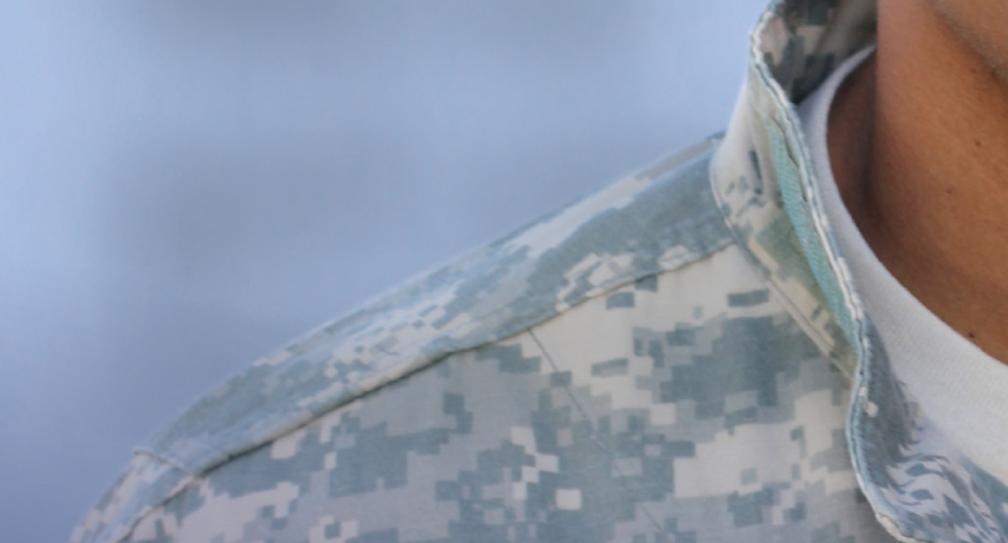










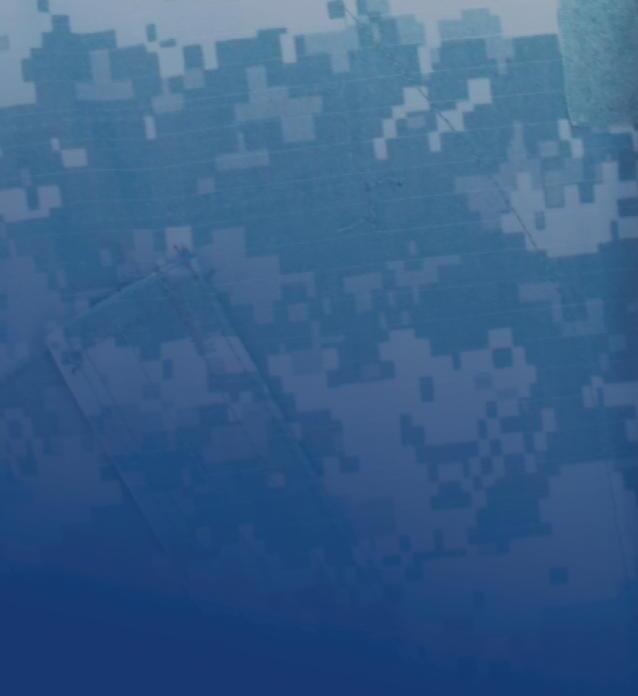
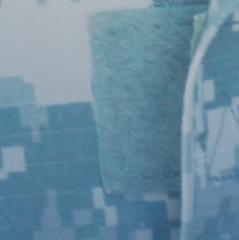

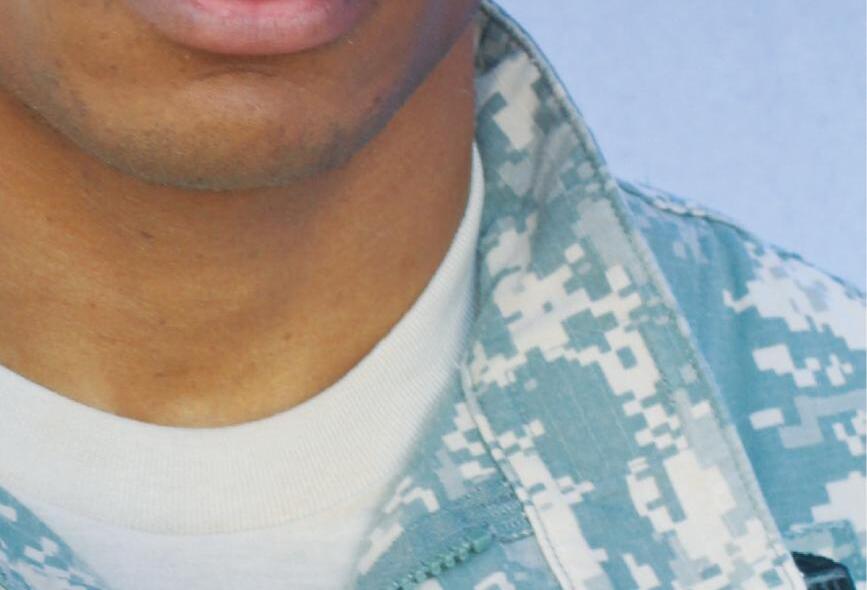
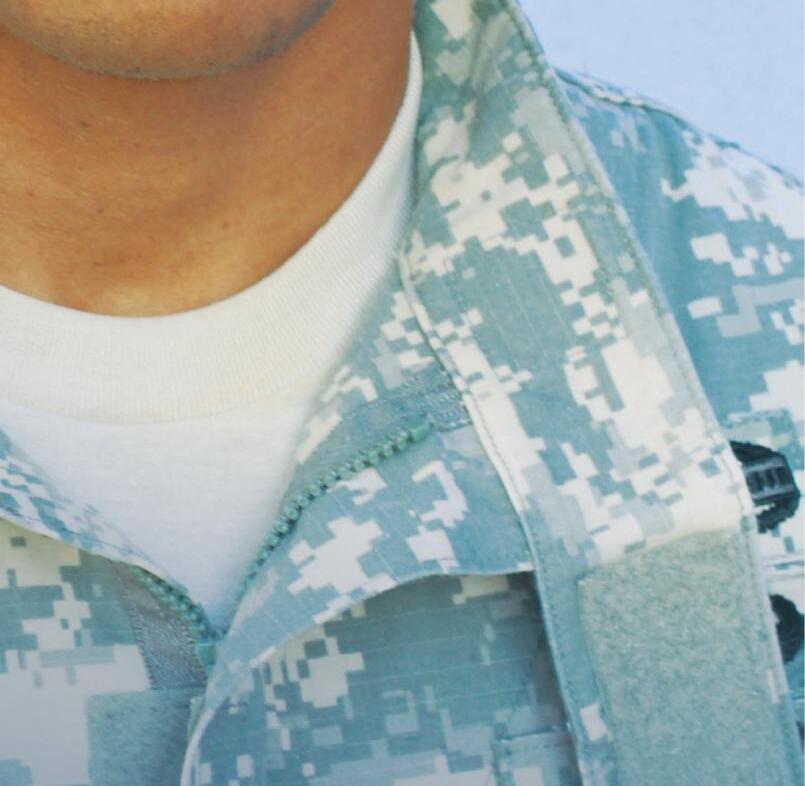










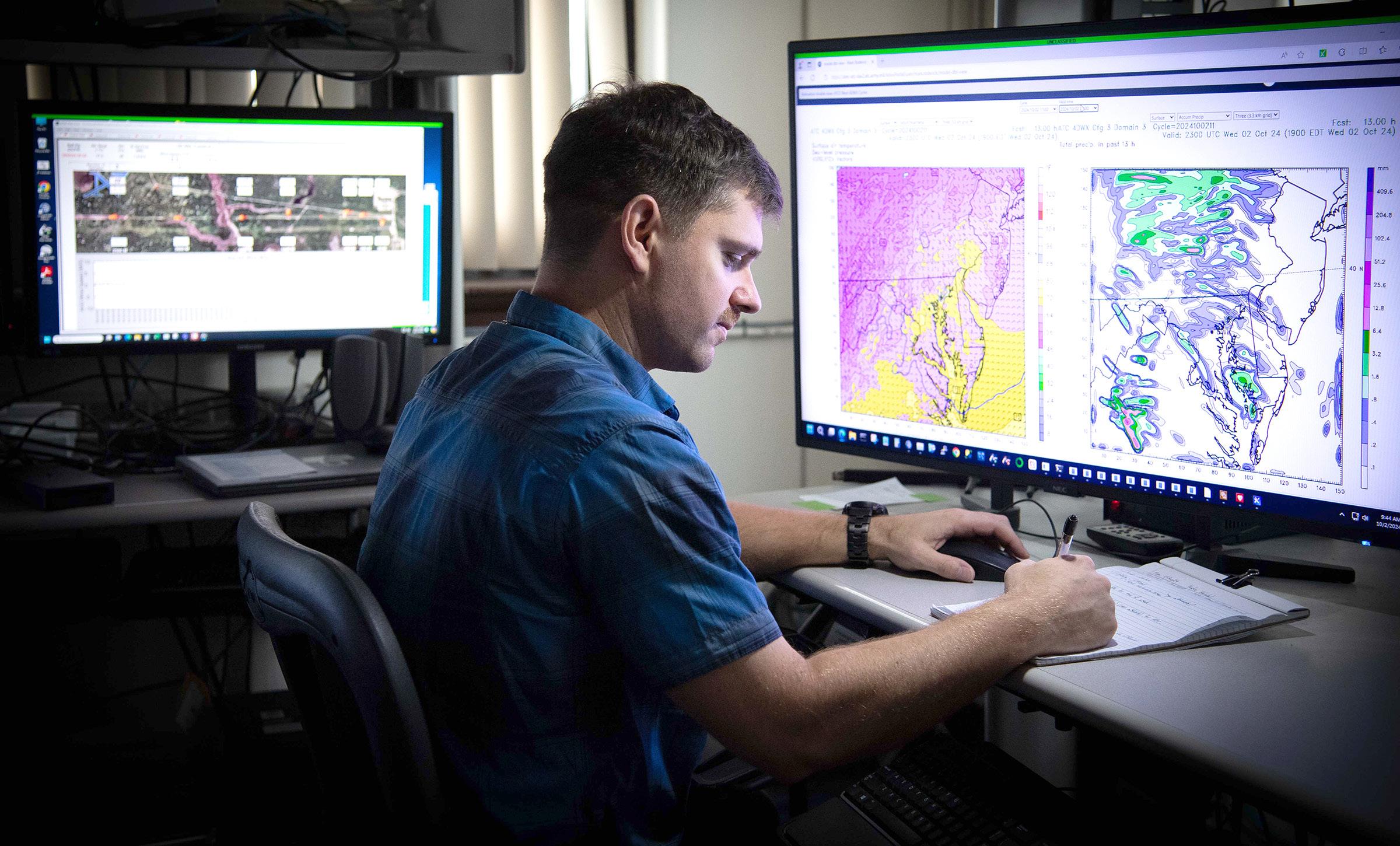
Rachel Ponder
CECOM Public Affairs
The U.S. Army Aberdeen Test Center’s Atmospheric Effects Team analyzes weather conditions to ensure testing is conducted safely and accurately on Aberdeen Proving Ground. ATC is a subordinate command to the U.S. Army Test and Evaluation Command and is the DOD’s lead agency for landcombat, direct-fire, and live-fire vulnerability testing.
Michael Padovani is a meteorologist with the ATC. Padovani previously worked for the National Weather Service and has been with the ATC since 2005. His duties involve fieldwork, instrumentation, traditional
forecasting with weather models, and information technology.
The Atmospheric Effects Team comprises four people: two meteorologists, an electronic technician, and an engineering technician. According to Padovani, the team’s daily duties involve weather monitoring and producing short-term and medium-range forecasts at the beginning of the workday for ATC employees, many of whom conduct testing outdoors.
“The Atmospheric Effects Team plays an important part in making sure that testing happens safely and that the weather is accurately documented so we can understand the impacts on the systems being
tested,” said Deirdre Cascardo, ATC public affairs specialist.
Padovani said APG is a good location for testing because of the variety of seasons and weather patterns.
“APG provides the Army, our sister services, partner agencies, and allies the ability to test and evaluate within significantly varying conditions throughout the year,” said Mark Roderick, a meteorologist with the ATC.
Weather variations include temperature swings of more than 100 degrees Fahrenheit, with temperatures just below 0 F on the coldest winter days to just above 100 F on the hottest summer days.
Another variation is the atmospheric moisture content. Seasonal and diurnal differences between coastal and inland locations on APG can also result in corresponding differences in temperature and wind.
“This makes APG unique compared to the rest of the Army’s test centers,” Roderick said.
Cascardo said testing in different weather conditions allows the Army to find and fix design issues that result from operating in dust, mud, snow, and ice.
“Testing in different conditions ensures our systems will work anywhere our warfighters are deployed,” she said.
The ATC uses a network of permanent weather instruments, or data collection platforms, around APG North and South. The team is responsible for monitoring and troubleshooting the equipment in the field to ensure it is working properly.
“Some of this instrumentation is for wind, temperature, humidity, solar radiation, pressure,” Padovani said. “The information is being collected at various timed intervals, usually at five and 15-minute intervals.”
A new capability the team uses is present weather sensors. Roderick said these sensors can measure rainfall rates, which allows them to assess the
risk of flash flooding while measuring total rainfall accumulations across the installation.
“With this information, we can better inform the base population of areas that are being impacted or that could potentially become inaccessible due to flooding,” Roderick said. “The sensors also provide us with current visibility and can depict what is causing a drop in visibility, whether it’s fog, smoke, haze, etc. This [ability] is helpful information to have when marine assets are needed for specific tests and target acquisition. Additionally, this data is collected every minute and databased to be used in studies such as groundwater and climatology of the post.”
Some ATC ranges have wind monitoring capabilities, which track wind direction, speed, and crosswinds. This state-of-the-art technology gives test officers accurate, real-time data, which is essential because certain tests, like those measuring ballistic conditions, require specific wind conditions to conduct.
“Real-time [data] is not always needed, but when it is, it usually is a factor in determining ‘go/no-go’s’ for firing,” Padovani explained. “For example, if a test has a crosswind limit of 5 mph, they’re going to need real-time winds down the line of fire. Providing that feedback to the test officer is important.”
Padovani said the ATC also releases weather balloons instrumented with radiosondes. These instruments provide upper-air observations. Radiosondes attached to weather balloons collect information on temperature, humidity, wind, and atmospheric pressure.
The ATC uses two versions of Weather Research and Forecasting models. WRF is a numerical weather prediction system for atmospheric research and weather forecasting. WRF models, used internationally at forecasting centers, allow researchers to produce simulations reflecting either real data or idealized atmospheric conditions.
Information from the WRF models feeds into ATC’s Four-Dimensional Weather System, or 4DWX, one of the most advanced weather programs available for meteorological support. 4DWX was first developed approximately 20 years ago with the National Center
for Atmospheric Research and continues to receive updates. It allows for rapid real-time data assimilation and visualization to provide the forecaster with the best data available to support the test effort. 4DWX technology was also used to analyze the potential exposure of U.S. troops to nerve agents during the first Gulf War and to support firefighters in Colorado and Arizona during summer wildfires in 2002.
“4DWX is a staple of Army technology,” Padovani said.
Padovani said 4DWX can provide detailed forecasts for APG North and South, typically up to six days in advance. In addition to predictions, 4DWX helps meteorologists find out what happened in the past by providing final analysis data.
“You can query that data back and actually find out what happened even if we don’t have a specific instrument at that location,” Padovani explained.
Padovani said that an important aspect to 4DWX’s visualization capability on APG is lightning monitoring, which is critical to protecting life and property.
According to the National Weather Service, lightning is a significant cause of storm-related deaths in the U.S. Padovani said when lightning occurs within 10 miles of the installation, a lightning advisory is issued, and outdoor testing is stopped.
Padovani said 4DWX is intertwined with the Noise Assessment Prediction System, a model that provides an assessment of noise levels that will result from testing activities. Since 4DWX is always assimilating observational data, the forecast routinely gets nudged to provide the most accurate prediction when running NAPS, which is operated by the ATC Environmental Office.
“The APG Garrison Noise policy lists a specific decibel level that we must maintain underneath that to be allowed to test,” explained Kimberley Fillinger, an environmental scientist with ATC. “We use the model to predict what the noise is going to look like for that particular day.”
Several factors can significantly influence how far
sound travels from its source and how loud it will be. These factors include wind, temperature, topography, and humidity.
Padovani explained that temperature inversions and wind shear can cause testing to sound much louder than usual or be heard at greater distances. The inversion layer acts as a boundary for the sound, trapping it close to the ground.
Fillinger said tests are rarely canceled because the predicted noise stays below the noise policy levels.
APG Garrison will send out a noise advisory on days when detonations are likely to generate sound or vibration outside the installation boundary.
Roderick said he was drawn to serving as an Army civilian because his father served in the Army, and weather fascinated him from an early age. Roderick was interested in tracking the weather, especially when school was closed due to a snow day.
“My mom would joke, I knew what room you were in because when we turned on the TV, it was on the Weather Channel,” he laughed.
Roderick also wanted to learn more about the science and mathematics behind the weather. This interest led him to earn bachelor’s and master’s degrees in atmospheric science at the University of Massachusetts-Lowell.
Roderick started with ATC in 2018, part-time, in the Pathways Internship Program. In 2023, he joined the team full-time. He also serves as a first lieutenant with the Massachusetts Air National Guard as a staff weather officer. Roderick said he enjoys the variety of his work and especially appreciates the days he can work outdoors in the field. Knowing he can use his expertise to support the warfighter is also a big plus.
“I love the way that weather is injected into military planning and how we can support the decisionmakers with weather and environmental intel,” he said.
Members of the ATC Atmospheric Effects Team lend their expertise and provide forecasting information to the APG Destructive Weather Group, which meets
before a predicted destructive weather event, such as blizzards and tropical storms.
The Atmospheric Effects Team provides additional forecast information and unique local effects that supplement the National Weather Service forecast. This information is used to brief the APG Senior Commander and other leaders.
“Ultimately, a recommendation is made to the APG Senior Commander, who then decides what action should be taken,” Padovani said.
According to Padovani, APG’s preparation for a weather event can vary, depending on the anticipated storm. For example, during a snowstorm, personnel are mobilized for snow removal and ice melt is distributed to facilities. Other preparations can include checking and cleaning storm drains,
securing exterior items, topping off fuel for generators, ensuring bottled water is available, and preparing shop equipment. The ability for the workforce and residents to safely enter and exit the installation is another big factor to be considered. Alerts are sent out to the workforce to keep informed.
Padovani said a major weather event requires significant coordination with APG Garrison, including fire, police, housing, and child and youth services. Destructive Weather Group recommendations can occur early in the morning or later in the afternoon depending on the timing of the event, forecast confidence, or severity.
“We are one piece but critical nonetheless at establishing what can be expected to ensure protection of life and property,” Padovani said.
After U.S. Army veteran Jake Norotsky’s deployment to Iraq, his posttraumatic stress (PTSD) was so severe he considered suicide. After he registered for Wounded Warrior Project® (WWP), he realized that other veterans shared similar experiences and that he was not alone. Today, Jake has a new mission: to connect with audiences around the nation by sharing his story. When you pledge your Combined Federal Campaign donation to WWP, you will help provide injured veterans and their families access to lifechanging programs and services to help them reach their highest ambition. Visit GiveCFC.org or scan the QR code to make your pledge today.
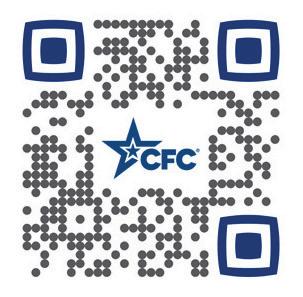




CONNECTED AND PROVING IT EVERY DAY.
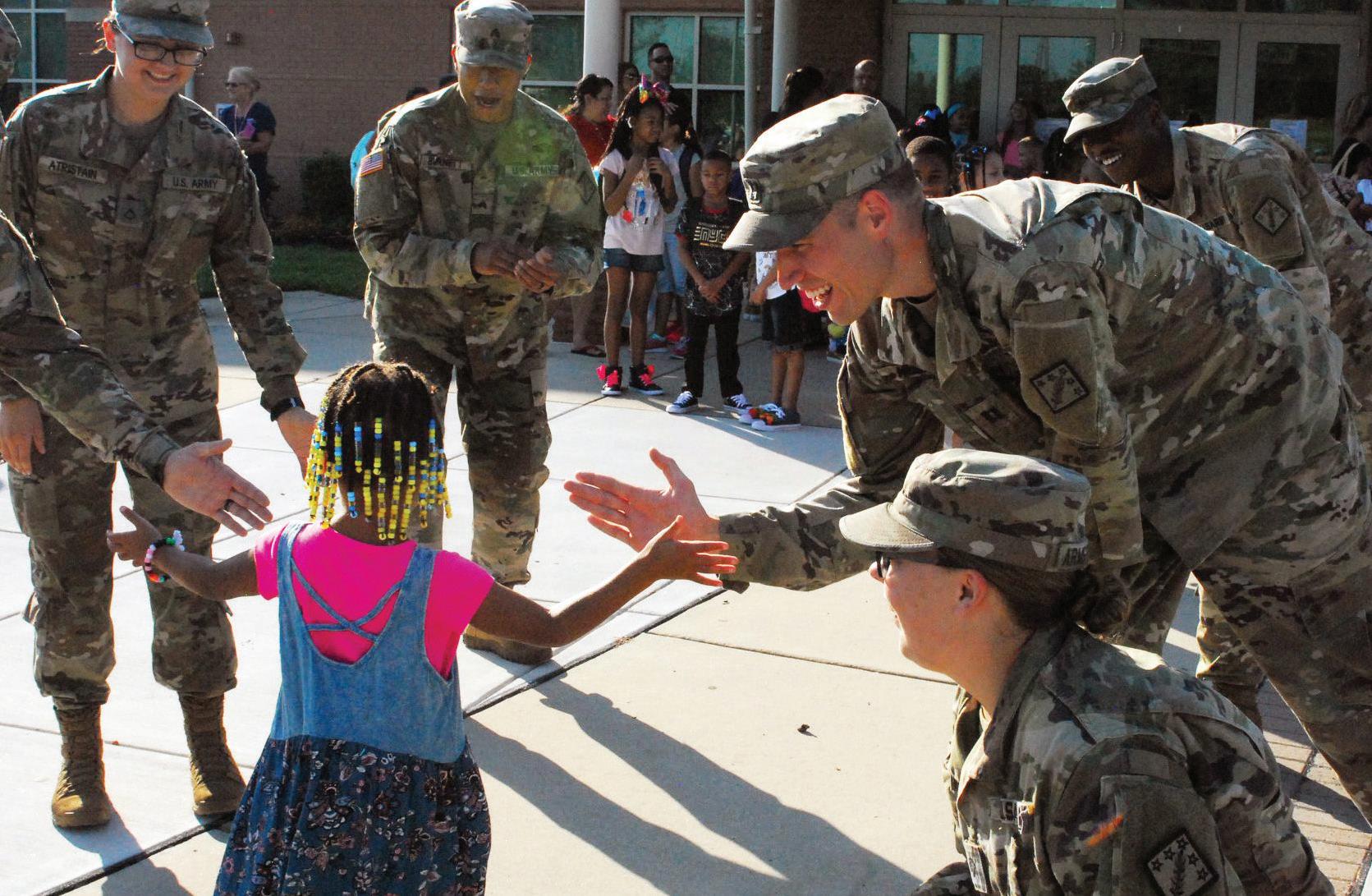


Aberdeen Proving Ground is home to generations of scientists, engineers, and technologists deeply rooted in the unique community energy of Northeast Maryland.


A team of seasoned U.S. Army Civilian microbiologists and chemists trained together with Jordanian troops
Army Civilians from the Chemical, Biological, Radiological, Nuclear, Explosives Analytical and Remediation Activity shared their expertise with partner nation CBRNE troops during Exercise Eager
According to U.S. Central Command, Exercise Eager Lion is the most important exercise between the U.S.
“Eager Lion demonstrates the value of working together to maintain a ready and responsive force that truly demonstrates we are prepared to respond together in times of crisis,” said U.S. Army Brig. Gen. Jason Benson, U.S. Central Command’s director for Exercise Eager Lion 2024. “Participating in Eager Lion demonstrates our shared commitment to improving interoperability with our partners. It also demonstrates that our coalition force can maintain a sufficient and sustainable presence in the region. It delivers a clear
Richard A. Trombly II, the laboratory manager for CARA, said his Army Civilian team successfully integrated with Jordanian troops during the
“The highlight of the training was conducting joint CBRNE laboratory operations,” said Trombly, a native of Clearwater, Florida, who earned his bachelor’s degree in microbiology from the University of South Florida and his master’s degree in microbiology and
“Operating both [U.S. and Jordanian] mobile laboratories concurrently displayed the ability of personnel from CARA and the Jordanian Armed Forces Chemical Support Unit to work together, overcome any obstacles, and successfully execute,” Trombly said. “Working together with partner forces was a good opportunity to share experiences as well as
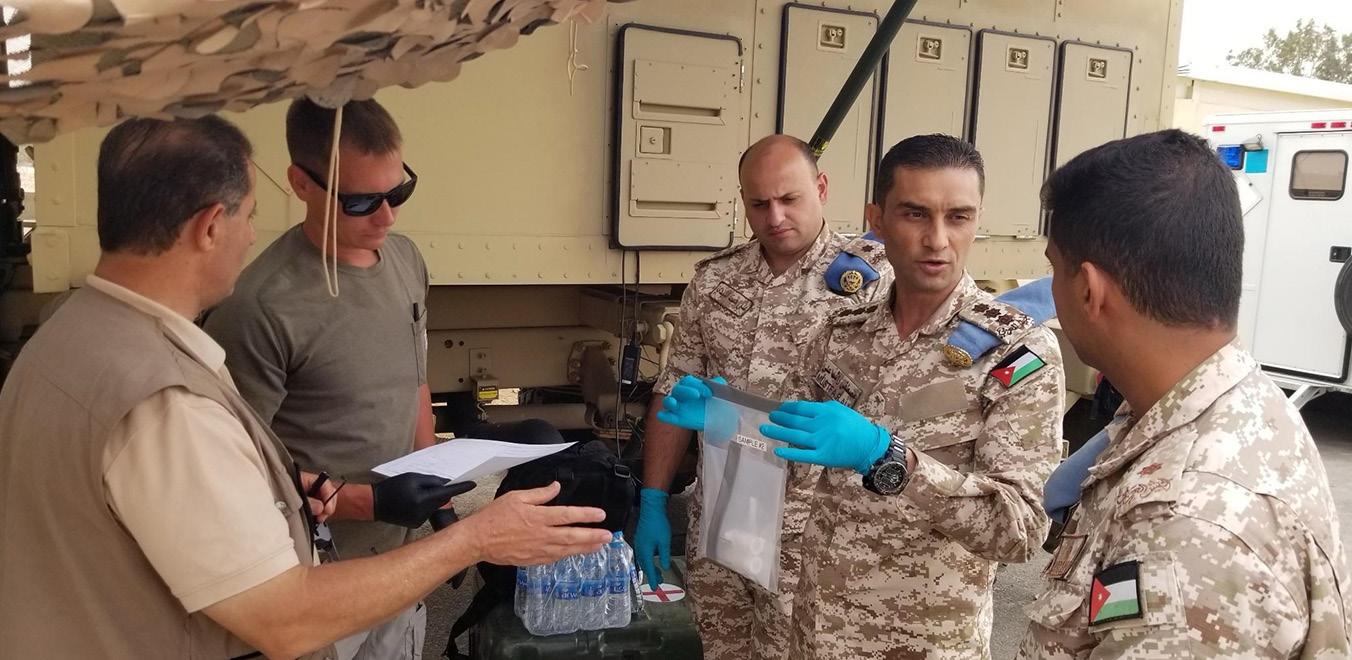
A team of U.S. Army Civilian microbiologists and chemists trained together with Jordanian troops at the Joint Training Center near Zarqa, Jordan. Army Civilians from the Chemical, Biological, Radiological, Nuclear, Explosives Analytical and Remediation Activity shared their expertise with partner nation CBRNE troops during Exercise Eager Lion. |Courtesy photo, CBRNE
tactics, techniques, and procedures expanding the knowledge for both teams.”
CARA scientists brought a vast amount of experience to Eager Lion 2024. Many of the Army Civilians at CARA have their doctorates in their respective professions and serve as microbiologists and chemists in the U.S. Army.
Kevin Wioland, a CARA chemist, served as a team lead and built training sites at numerous bases and trained troops on handheld chemical detectors used for exploitation missions.
Irv Swahn, a CARA chemist who previously served as an Organization for the Prohibition of Chemical Weapons inspector at the Hague in the Netherlands, presented a comprehensive briefing on the Chemical Weapons Convention during the exercise.
Dr. Clarisa Carrizales, a former Drug Enforcement Agency chemist who joined CARA in 2023, briefed the Jordanian Armed Forces on general chemistry and mass spectral interpretation.
Dr. Michelle “Mitch” LaFrance, a CARA microbiologist who previously deployed in support of Operation Inherent Resolve; Dr. Edward Keen, a CARA microbiologist who also serves as a lieutenant colonel in the Army Reserve; and Dr. Samuel Pannoni, a CARA microbiologist and expert in bioinformatics, shared their expertise with Jordanian Armed Forces troops during Exercise Eager Lion.
Franz J. Amann, the director of CARA, said his CARA civilian scientists use their expertise to enable mission readiness and protect U.S. and partner service members.
“Our expeditionary laboratories are capable of deploying anywhere in the world to serve alongside our friends and allies,” said Amann, a retired U.S. Army Chemical Corps colonel from Spartanburg, South Carolina.
“Our Army Civilian chemists and microbiologists use state-of-the-art equipment and operate under International Organization for Standardization certification 17025,” Amann continued. “This internationally recognized certification ensures all tests and controls follow strict established standards. As the supported command receives our theater validated data, the commander and his staff have the highest confidence in the data to make required operational decisions.”
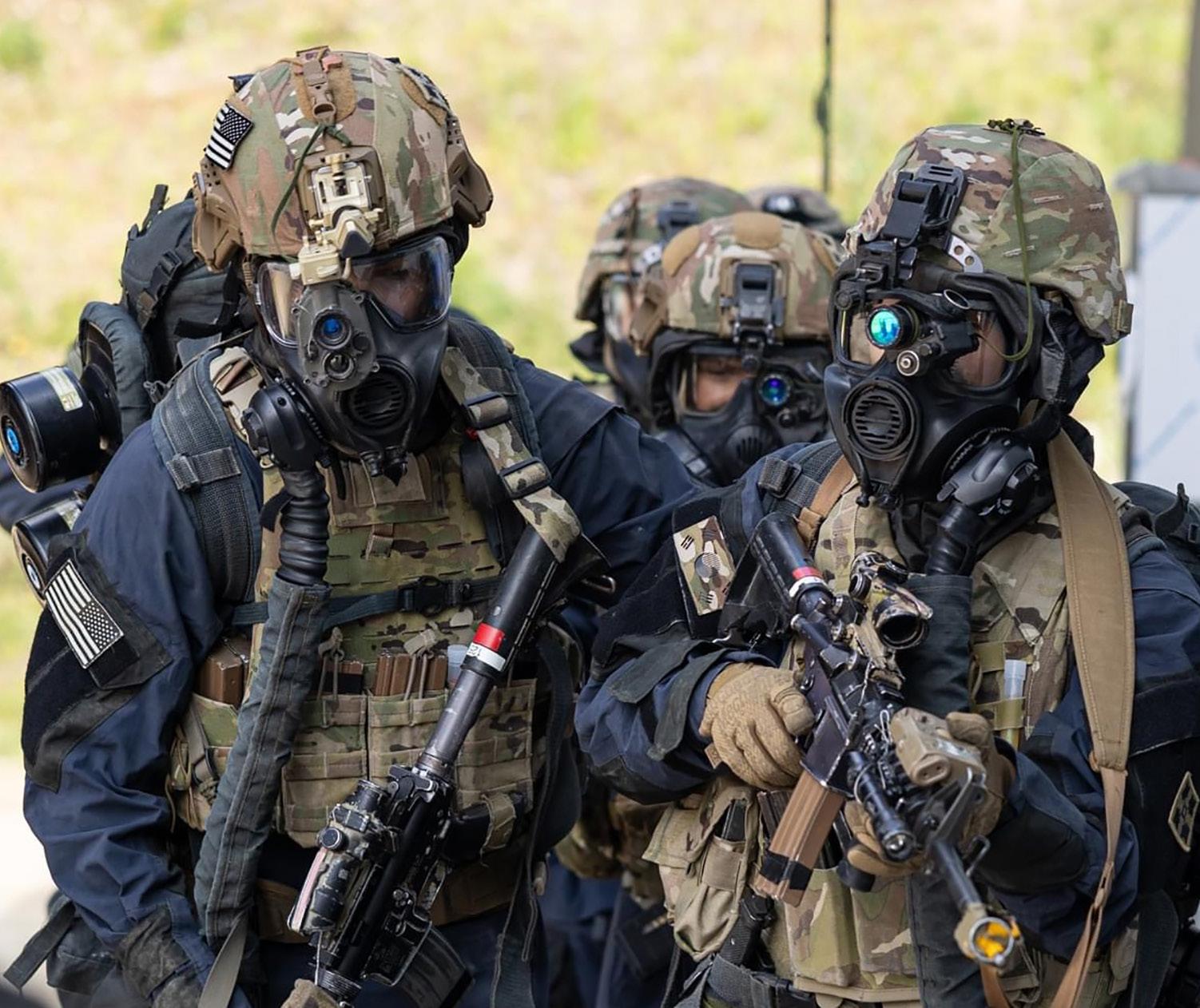
American Soldiers from the 59th Chemical, Biological, Radiological, Nuclear Company (Hazardous Response) “Mountain Dragons” are bolstering the Republic of Korea-U.S. Alliance combined defense posture during a rotational deployment near the Korean Demilitarized Zone. Since arriving in South Korea in July 2023, the Fort Drum, New York-based CBRN company has trained with maneuver forces for a wide variety of combat missions. |Courtesy photo, CBRN
Walter T. Ham IV 20th CBRNE Command
The U.S. military’s premier deployable and multifunctional Chemical, Biological, Radiological, Nuclear, Explosives Command participated in Ulchi Freedom Shield 24 in South Korea, Aug. 19-29, 2024.
Soldiers and Army Civilians from the 20th CBRNE Command trained with Eighth Army and Combined Forces Command units during the exercise.
Conducted to strengthen Republic of Korea-U.S. Alliance, UFS 24 is a routine and defensive-oriented exercise designed to strengthen security on the Korean Peninsula and stability in Northeast Asia. The annual exercise integrated live training and constructive simulations that brought together South Korean, American, and multinational member states.
The training events focused on conducting multidomain operations leveraging land, sea, air, cyber, space assets, and non-kinetic effects.
Soldiers and Army Civilians from the 20th CBRNE Command routinely deploy to South Korea for exercises and send a Chemical Corps company to support rotational forces.
One of the 20th CBRNE Command’s Weapons of Mass Destruction Coordination Team supported the annual exercise.
WCTs deploy and provide combatant commanders, lead federal agencies, or supported commanders with specialized CBRNE staff support and technical expertise.
U.S. Army Brig. Gen. Derek N. Lipson, Special Operations Command-Korea commander, presented Soldiers from the WCT with the Korea Service Defense Medal for their service during the exercise.
Maj. Steven M. Modugno, 20th CBRNE Command public affairs director, said the 20th CBRNE Command routinely trains with South Korean CBRN Defense Command forces on the Korean Peninsula and at combat training centers in the United States.
“It is always an honor to train together with ROK military partners during exercises on the Korean Peninsula,” said Modugno, a native of Santa Clarita, California, who previously served with the South Korea-based 2nd Infantry Division. “For more than 70 years, U.S. troops have proudly stood shoulder-to-shoulder with our South Korean allies on Freedom’s Frontier and defended liberty together.”
Parker Martin DEVCOM CBC Public Affairs
The U.S. Army Combat Capabilities Development Command Chemical Biological Center had the opportunity to host two high school teachers in the Army Education Outreach Program’s Research Experiences for STEM Educators and Teachers initiative. This multi-week “internship” for teachers focuses on providing high school or middle school STEM educators with a lab-focused professional development program coupled with a summer research experience at one of the many participating Army research laboratories and centers.
RESET, an Army funded program that takes K-12 educators nationwide and immerses them in a genuine summer research experience, is designed to equip them with the necessary tools to provide students with applied STEM concepts within realworld contexts.
The two interns, Sistina Martin and Caitlin Meador, are both STEM instructors from the same school district in Crossville, Tennessee. Martin, a ninthgrade instructor specializing in biology, chemistry, and ACT test prep, is on her second year of the RESET program. Meador teaches middle school science. Both were personally invited to experience the program from Dr. Jennifer Meadows, associate
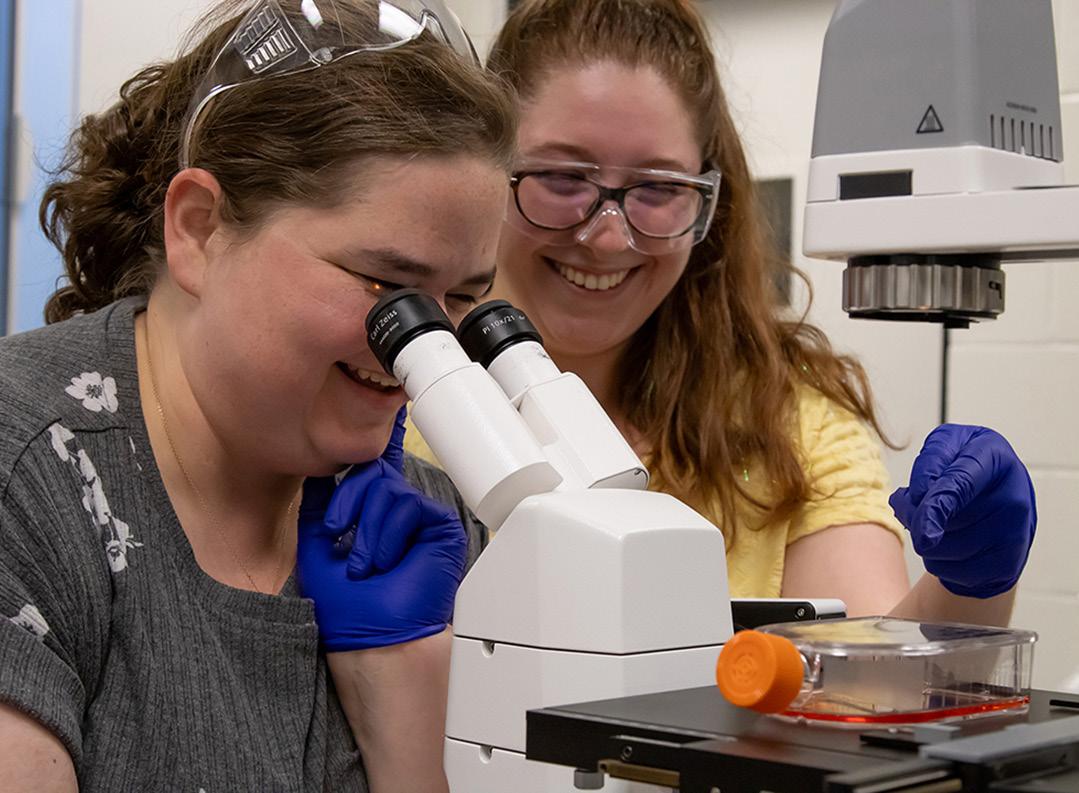
professor at Tennessee Tech University and director of AEOP’s RESET program.
“We both went to Tennessee Tech and know her very well—she reached out personally,” said Martin.
“Dr. Meadows met with me and said, ‘I have another space; do you want it?’ and I said absolutely – it’s such a good opportunity that few get.”
Both Martin and Meador have master’s degrees
in STEM subjects but noted the lack of real-life application that comes with college lab courses. With a heavy emphasis for hands-on experience, the RESET program gave teachers both new experiences and motivations to bring back to their classrooms.
“You take a lot of courses in college, but all the labs in particular are set in stone,” said Martin. “You follow protocol and it’s like you’re not doing real research. You don’t have the opportunity to ‘break new ground’ and work with new materials or work out problems, when in the real world [here at DEVCOM CBC] you collaborate. That’s what happens when you’re researching and working as part of a team in science. You don’t often get the opportunity to teach that in the classroom.”
“We get to be in an actual lab with actual scientists,” said Meador. We’re watching them research and helping them work. It’s easy to see how it connects back to the classroom with real-world concepts to reference. I never had the opportunity to work in a lab before and it’s amazing—I learned so much and such an amount of information that is truly fascinating.”
The RESET program’s success stems from the quality of the teachers that are accepted, coupled with the guidance of experts from the wide range of Army centers across the nation. As director of the RESET program and member of the AEOP Consortium Management Committee, Meadows ensures that the right teachers are paired with the right mentors for optimal growth in their mutual fields, vying mostly for
educators that value inquiry, creativity, and innovation in the classroom. Meadows also actively recruits for RESET, presenting at multiple educator conferences throughout the year, such as the National Science Teaching Association conference.
“Our teachers report gains in their STEM knowledge, overall confidence in teaching STEM and increased understanding of careers relating to STEM,” said Meadows. “The mentors, likewise, have shared that while our RESET educators are much like other interns they work with, the maturity and experiences of RESET educators set them apart as valuable members of their research teams.”
The mentors are just as integral to the operation as the selected mentees. Dylan Fudge, a research biologist with CBC’s Molecular Toxicology Branch, says that having eager STEM instructors to assist brings with it benefits beyond just an extra set of hands.
“Personally,” says Fudge, “it helps us reinforce concepts—brings us back to the basics. They are shadowing all our organ-on-a-chip projects, studying in our zebra fish laboratory as well as working in our 3D printing facilities at the MakerSpace lab. They were ecstatic to be growing their own cells. It kind of reinvigorates your love for the job.”
“It’s been a wonderful experience,” said both Martin and Meador. “We assist in any way we can just be a helping hand. We’ve visited more than just this lab, yet so many people here want to teach you and help.”
Parker Martin DEVCOM CBC Public Affairs
U.S. Army Combat Capabilities Development Command Chemical Biological Center, in co-sponsorship with the Chemical, Biological, Radiological, Nuclear, and Explosive Society, hosted the NCT USA conference from Sept. 3-5, 2024, at the Chemical Demilitarization Training Facility at Aberdeen Proving Ground, Maryland.
The conference is designed to enable collaboration
among high-level decision makers and experts in CBRNE threats from across the globe including members from the counter improvised explosive devices and explosive ordnance disposal communities. The forum provided a world-class networking and knowledge exchange platform for government and military senior leaders, local and federal first responders, academia, as well as industry partners in the field.
“This is our 4th year of co-hosting—I’m not sure there’s another event that brings together a community like

Participants at the 2024 NCT USA’s PRO eXperience simulated a training scenario where the FBI Hazardous Evidence Response Team were sent into a building where people were manufacturing weapons of mass destruction. The participants were then sent in with gear that could detect/identify chemical agents. The PRO eXperience is meant to foster interoperability of first responders while introducing teams to the latest in the Chemical, Biological, Radiological, Nuclear, and Explosive defense. |Ellie White, DEVCOM CBC
this,” said DEVCOM CBC Director Michael Bailey as he addressed the audience during his opening remarks. “There are key elements of the CBRNE enterprise here with us today, so talk to them. They’re the ones that will be able to answer the question of, ‘is this capability able to turn into a real-life thing?’ This event is a way to make those technologies come to life.”
Over the duration of the three-day-long conference, NCT USA’s 400+ attendees were able to participate in the main hall’s tech exhibition for government and industry stakeholders to preview potential collaborations, and a Dragon’s Pitch, which allows members from all communities to present their ideas in a “shark tank” environment for industry awareness. Attendees also had the opportunity to attend an NCT PRO eXperience, which fosters interoperability of first responders while introducing teams to the latest CBRNE, C-IED, and EOD technologies.
On day two of the event, Bailey briefed the audience alongside a roster of keynote speakers, including APG senior leaders Dr. Eric Moore, deputy to the DEVCOM
commanding general, and Darryl Colvin, Joint Program Executive Officer for Chemical, Biological, Radiological and Nuclear Defense. All were eager to welcome attendees and give insight into what their organizations have to offer while posing questions for the upcoming walkthrough on to the showroom floor.
“Modernization is just one element of the DEVCOM mission,” said Moore. “We’re looking towards total transformation. We need new processes, new partners, and increased surety so that our warfighters have the best capabilities ever. No matter where we are in the materiel lifecycle, we’re impacting it—but we can’t take all the credit since we have so many partners. These kinds of events ensure that we keep fostering those partnerships.”
The international and inter-organizational aspect of the CBRNE field is one of the community’s strongest assets. With partners from around the globe in attendance, NCT USA remains a pivotal event to catalyze collaborative efforts in CBRNE defense.

On July 19, 2024, the Joint Program Executive Office for Chemical, Biological, Radiological and Nuclear Defense held a wearables experiment demonstration and Soldier touchpoint event. During the demonstration, the JPEO-CBRND interns supported the experiment by assisting with data simulation, monitoring, engineering, and feedback. The demonstration was held to prepare for the upcoming Beholder’s Gaze exercise in October. During this event, JPEO-CBRND interns were geared up with CBRN protective equipment that were monitored to help illustrate the power and utility for JPEOCBRND senior leaders and DOD partners in attendance during the exercise. |Alex Hillman, JPEO-CBRND Public Affairs
Alex Hillman
JPEO-CBRND Public Affairs
This summer undergraduate and recent grads participated in the DOD Historically Black Colleges & Universities and Minority Serving Institutions summer research program and the Army Educational Outreach Program internships. These young professionals were busy solving STEM challenges alongside staff at the Joint Program Executive Office for Chemical, Biological, Radiological and Nuclear Defense and U.S. Army Combat Capabilities Development Command Chemical Biological Center.
Students with STEM backgrounds from HBCU/MIs and various universities around the country worked
for the Army, gaining valuable experience and building new talents, skills and problem-solving capabilities needed for a more diverse, motivated and skilled civilian workforce.
The JPEO-CBRND and DEVCOM CBC rely on a strong STEM-based workforce to achieve critical needs within our organizations.
The HBCU/MI program is supported by Office of the Under Secretary of Defense for Research and Engineering and attracts students with wide ranging backgrounds and interests, from chemical engineering, cyber security, and material science.
The DOD benefits from training these scholars. During the program, interns present their research at symposiums attended by DOD scientists and
engineers, keeping DOD staff connected to the latest knowledge and expertise. Additionally, 14 of these interns supported the JPEO-CBRND in a live demonstration event for the JPEO-CBRND’s Office of the Chief Engineer Wearables Experiment. The Wearables Experiment team will participate in a large-scale CBRN defense exercise this fall.
To prepare for the exercise, the JPEO-CBRND recruited interns to support data generation and real-time modeling of the OCE wearables technologies. The wearable devices are in testing across the DOD and under consideration for use by the joint force to enhance CBRN threat detection and general biometric monitoring.
Wearables provide the services with tools that can clear some of the “fog of war,” through better situational awareness of both unit and personal fitness and readiness indicators looking at things like hydration, temperature, heart rate, respiration levels, fatigue, and “body battery.”
The various wearables (e.g., smart watch, Oura ring, and more) are monitoring and reporting for things like heat strain, illness, the status of protective gear (e.g., a CBRN mask), or other critical resource indicators.
The in-house JPEO-CBRND leadership demonstration was organized to help the Wearables Team prepare and refine their approach this fall and to give JPEO-CBRND leaders a way to discuss the capabilities and interoperability of this technology.
During the live demonstration, the team simulated a CBRN event for both chemical and biological scenarios and watched as the data from the interns poured back to the simulated Joint Tactical Operations Command Center, where leadership participated in the tabletop exercise.
The exercise had representation from all services and the attention of senior DOD leadership—so the team brought in the intern support to better prepare the scenario and technology for prime time.
Without real-time data generation, leadership

During the wearables demonstration the Joint Program Executive Office for Chemical, Biological, Radiological and Nuclear Defense interns supported the experiment by assisting with data simulation, monitoring, engineering, and feedback. Above, Darryl Colvin, JPEO, and Nicole Kilgore, deputy JPEO, meet with U.S. Army Combat Capabilities Development Command Chemical Biological Center and JPEO-CBRND interns to conduct after action reporting for the wearable technology demonstration. |Alex Hillman, JPEO-CBRND Public Affairs
would not have had the opportunity to see the power and innovation of the wearable’s technologies.
During the exercise, service members were equipped with the wearables that monitor heat and hydration levels and basic background biometrics, and provide real-time data for units, company, and even brigade-level decision makers. This allowed them the opportunity to learn about the products and benefit from the information each device provides.
Since warfighters have so much gear and equipment they need, it is critical to understand if adding these biometric and CBRN sensors is worth the extra hassle and weight.
To assist with this real-time need, on the morning of the wearables demonstration the interns were sent around Aberdeen Proving Ground North and South. Not only did they help the leaders in the command center visualize the data being generated by the wearables, but they were brought back into the mix to provide feedback and debrief the experience with JPEO-CBRND’s executive leaders.
The interns met with Darryl Colvin, JPEO; Nicole
Kilgore, deputy JPEO; and Gordon Graham, chief of staff for the JPEO-CBRND.
Interns shared their wisdom and thoughts with leadership about the exercise and the internship experience overall. It was a chance to trade insights on more than just the technology. Many shared their perceptions and feedback about what it was like to wear the gear, and what it felt like to be part of the experimentation and test process.
Meanwhile, Colvin and Kilgore shared their wisdom about the value of systems thinking, product design, and how critical the interns’ insights are in the JPEO-CBRND’s efforts to protect the nation’s warfighters.
“[I think] the wearables demonstration was fun and appreciated the inclusion in such a demo,” said Stephen Snyder, a rising junior studying mechanical engineering at University of Maryland College Park. “It gave me a more concrete idea of what the JPEO-CBRND develops, and how it gets used in the field.”
This was an illustrative and didactic experience that interns often will not get doing their own projects or research in a campus setting.
When asked about his guidance for future interns, Snyder recommended taking advantage of every opportunity.
“During my summer here, I’ve met a bunch of interesting people and heard their stories, and I was able to hang out with a bunch of other interns from all over,” he said. “I also got to take part in a couple of events, of which the wearables demo was my favorite.”
As the JPEO-CBRND and DEVCOM CBC interns return to their fall routines, our workforce is reflecting on the lessons they have learned from our intern workforce. They shared their energy, perspective, and willingness to roll up their sleeves. This provides our workforce with the needed energy to march forward toward the excitement of the exercise this fall.
When you donate a vehicle to benefit Wounded Warrior Project® (WWP), the money from its sale helps injured veterans and their families access free life-changing programs and services, and you receive a tax deduction.
To schedule a fast and easy pickup or to learn more, call 866.488.3244 or visit woundedwarriorproject.org/Fuel4WWP today.






HarfordCountybased photographer specializing in Family Portrait Sessions, Senior Portraits, &WeddingCelebrations
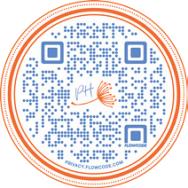
See samples &read reviews at www.pamelahar veyphotograph y.com


Residential Treatmentfor Children andAdolescents
We provide structured and nurturing treatment foryouth ages 9–17who struggle with emotional, behavioral and psychiatric disorders. Our programs areTRICARE®-certified.

We areh erefor yo uw hen yo un eed help fo ryour child. Find out more to daybyc alling 703 -7 77-0800 or visit northspringleesburg.co m.
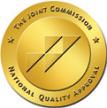
TRICARE® is aregisteredtrademark of the Department of Defense,Defense Health Agency. All rights reserved. For language assistance, disabilityaccommodations and the non-discrimination notice, visit our website. Physicians areonthe medical staff of NorthSpring Behavioral Healthcare, but, with limited exceptions, areindependent practitionerswho arenot employees or agents of NorthSpring Behavioral Healthcare. The facilityshall not be liable foractions or treatments provided by physicians. Model representations of real patients areshown.Actual patients cannot be divulged due to HIPAA regulations. 210269-8516 1/21










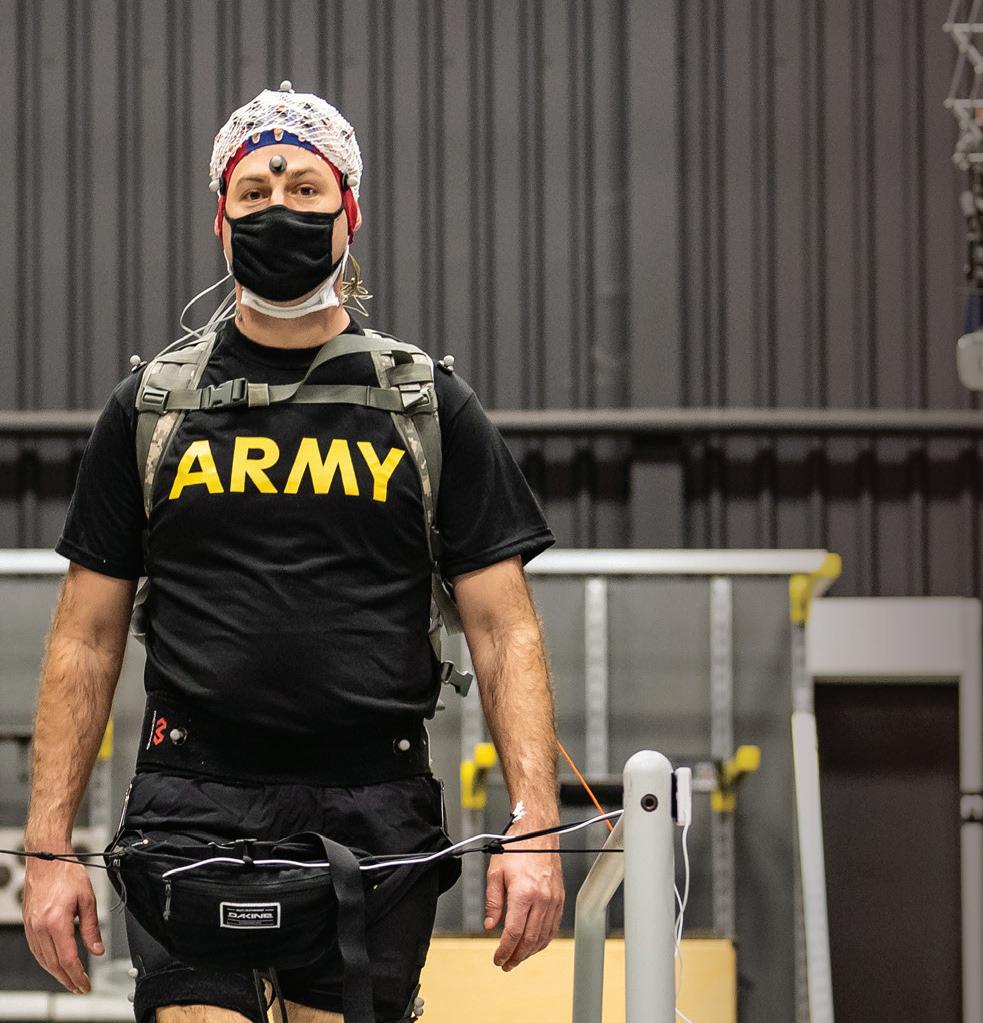





At Aberdeen Proving Ground, we create barrier-shattering innovations that forged our Nation’s history and guide our present day advancements to keep pace with emerging 21st century threats.


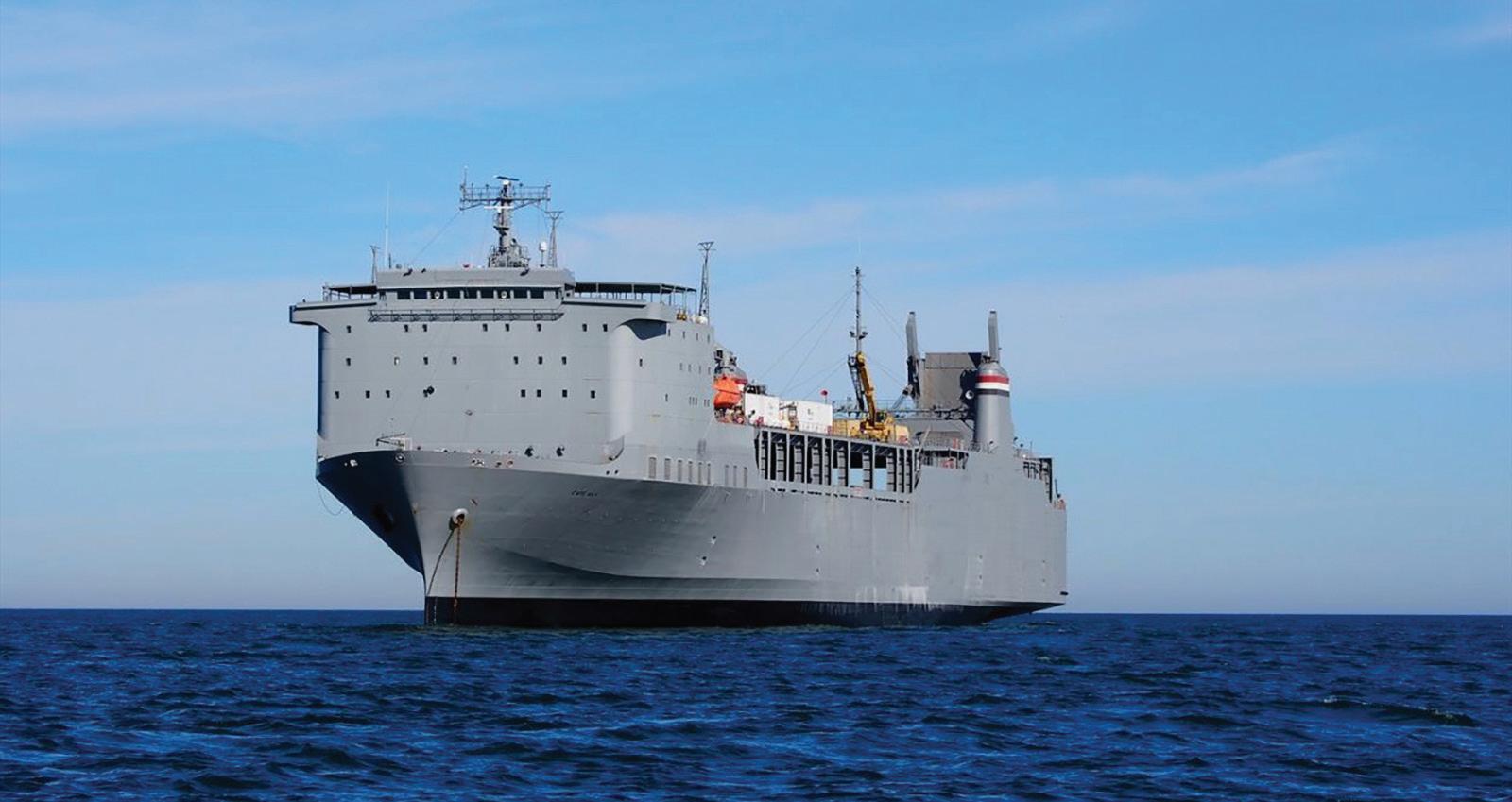
Dr. Brian Feeney DEVCOM CBC Public Affairs
Aug. 18, 2024, marks 10 years since an international effort allowed a team of demilitarization experts from the U.S. Army Combat Capabilities Development Command Chemical Biological Center to safely destroy more than 1,300 tons of Syrian chemical warfare material at sea.
It was late December 2012 and the Obama Administration’s national security team had a problem in Syria. A big problem. The Syrian government, enmired in a civil war, had agreed to turn over its stockpile of chemical agent—an estimated 1,300 tons—for destruction under the direction of the Organization for Prohibition of Chemical Weapons. The problem was that nobody in the OPCW, U.S. State Department, Pentagon, or the Defense Threat Reduction Agency had any idea how to carry out the destruction. That is when the deputy director of DTRA, Maj. Gen. Jay Santee and the State Department’s
point person for this mission, Richard Falkenrath came to the U.S. Army Combat Capabilities Development Command Chemical Biological Center’s Aberdeen Proving Ground, Maryland campus to meet with the organization’s field response arm, the Chemical Biological Application and Risk Reduction business unit. CBARR had decades of experience destroying recovered chemical agent munitions all over the world—including Iraq—and these visitors knew that if anybody could do it, it would be CBARR.
They presented their problem to CBARR Chief Timothy Blades and his team as a hypothetical, proposing the possibility of incineration as a way to get the job done in an austere environment on the other side of the world. Blades shot the idea down immediately. It would take too long to build, require too many people to operate and require too large a logistics train. Hydrolysis was the way to go according to Blades. Mixing the agent with hot water and a caustic compound to render it a conventional industrial waste made more sense to him.
Hydrolysis only required mixing vessels, storage containers, piping, valves, and pumps. It would be much easier to build, transport, operate, and disassemble than an incinerator. CBARR was also experienced with it, having used it to assist the U.S. Army Chemical Materials Agency with the destruction of two different stockpiles on U.S. soil.
The meeting adjourned with Blades telling his visitors, “Yeah, we can do this. I don’t know exactly how, but we’ll find a way.” Falkenrath knew at that moment that he was dealing with highly operational, no-nonsense people, as was captured by Joby Warrick in his book, “Red Line,” which recounted the events surrounding Syria’s use of chemical weapons at that stage of its civil war.
CBARR rolls up its sleeves
Blades put his mechanical engineers and electricians to work right way. They worked off Blades’ simple sketches depicting a very small field deployable hydrolysis system that could be easily assembled and disassembled, and would fit in tight spaces yet be sturdy enough to withstand transport across the world. A month later, Blades had a blueprint to take to the Pentagon.
The reception he received was “What do you need?” and “How soon can you build them?” They wanted three: two for deployment and one as a backup. Blades told them he needed $3 million and that he could have them by mid-summer 2013.
In June 2013, the CBARR team demonstrated their system: a modularized FDHS that could be disassembled and fitted into standard shipping containers. It was designed for ease of maintenance and avoided digital gauges and sensors, reasoning that tried-and-true analog would be more durable and easier to operate and maintain. It came with a portable laboratory for testing batches to ensure complete agent destruction, power generation, an array of storage tanks, and all the piping needed to move the liquid agent through the system. The team also doubled up on valves and pumps colorcoded for plug-and-play assembly upon arrival.
The CBARR team had delivered a working prototype within six months and within a very modest budget by Pentagon standards. The Pentagon then ordered a total of seven to be built.
The mission gathers urgency
Meanwhile, the State Department, DOD, and OPCW were very busy. In August 2013, the Syrian government
used a chemical agent against its own people in the Damascus suburb of Ghouta. In September, U.S. and Russian representatives negotiated the Syrian government’s surrender of its chemical agent stockpile in a three-day conference in Geneva. When the discussion turned to the method of destruction, Jeff Harris, a mechanical engineer and project manager for the U.S. Joint Program Executive Office for Chemical, Biological, Radiological and Nuclear Defense, was at the table. After the Russian delegation scoffed at the portable hydrolysis method as “totally impossible,” he walked them through a diagram of the FDHS. A Russian chemical destruction expert was present. He understood Harris’ explanation and declared, “This will work.” Thirteen days later the OPCW and the U.N. Security Council approved a destruction agreement.
Still left to do was the daunting job of rounding up the Syrian chemical agent stockpile stored in caches of varying size all over the country, in the middle of a civil war. As the round up proceeded, the CBARR team learned that the agents they would have to destroy were a precursor to the nerve agent Sarin known as methyl phosphonic difluoride and mustard, a blister agent. And then there was the issue of finding a destruction site. No ground for the FDHS to stand on—but lots of ocean
No nation was willing to host the destruction of these agents on its own soil, so in October 2013, CBARR was asked to explore the possibility of performing destruction operations at sea. While CBARR had no experience with maritime operations, they learned as much as they could as quickly as they could. They traveled to seaports around the country learning about the different kinds of ships available. It quickly became clear to them that the two-story high FDHS would require a ship with high ceilings in its interior.
That pointed them toward a type of cargo ship known as roll-on/roll-off, or “roro” for short. In this class was the U.S.-owned Motor Vessel Cape Ray. It was 647 feet long, 105 feet wide with four decks including an unusually spacious trailer deck. The CBARR team calculated that they had room for the actual FDHS units in which destruction occurred, the many storage tanks that would be required plus room for living quarters; a kitchen, mess hall, medical clinic, exercise room, and sleeping pods. Those would be inside standard cargo shipping containers bolted to the deck.
The main trailer deck in which the two field deployable hydrolysis systems were located was made air-tight and kept under negative air pressure in case any agent leaked during operations. The CBARR team also had to account for the stresses to the FDHS unique to a sea voyage. They replaced rigid hoses and pipes with flexible ones that could roll with a pitching sea. Other equipment had to be given additional welds and bolts. Working through the winter holidays, the CBARR team, with the help of the MV Cape Ray crew, completed construction inside the ship by New Years Day 2014. The construction phase included a sea trial that lasted three days. They steamed out of Norfolk, Virginia and into a North Atlantic gale. The team added coping with sea sickness to their list of mission stressors. However, the stress test was very valuable in determining where and how to secure the system’s many parts to the ship. An appointment with 1,300 toxic tons
The job of hauling the declared stockpile caches out of bunkers around Syria was underway. The caches of chemical agent were placed on board a Danish cargo ship, the Ark Futura, as they were collected. By January 2014, the CBARR team was on the MV Cape Ray and ready to rendezvous with the Danish ship in international waters in the Mediterranean Sea. But a sudden polar vortex over the Mediterranean burst the MV Cape Ray’s PVC piping. President Barack Obama himself was informed. In addition, collecting all 1,300 tons of agent from around the country was taking longer than anyone anticipated.
The CBARR team and MV Cape Ray crew sat idle at a U.S. Navy base in Rota, Spain just west of Gibraltar. The weeks and months went by as the dispersed stockpile was collected. Blades busied his team with fire drills, spill response drills, and maintenance checks. But they were bored and frustrated, and Blades worried about members of his all-volunteer team deciding that their families had endured long enough without them and returning home. None did.
Come June, 90 percent of the stockpile had been loaded, but the Danish ship could not set sail until it had all 100 percent as any disruption in collection might end the effort altogether. The U.N.’s June deadline was now defunct, and the Italian and Greek chapters of Greenpeace were following the news on the operation and getting restive.
To add to the Danish ship’s woes, the constant jostling caused by waves caused leaks in some of the agent
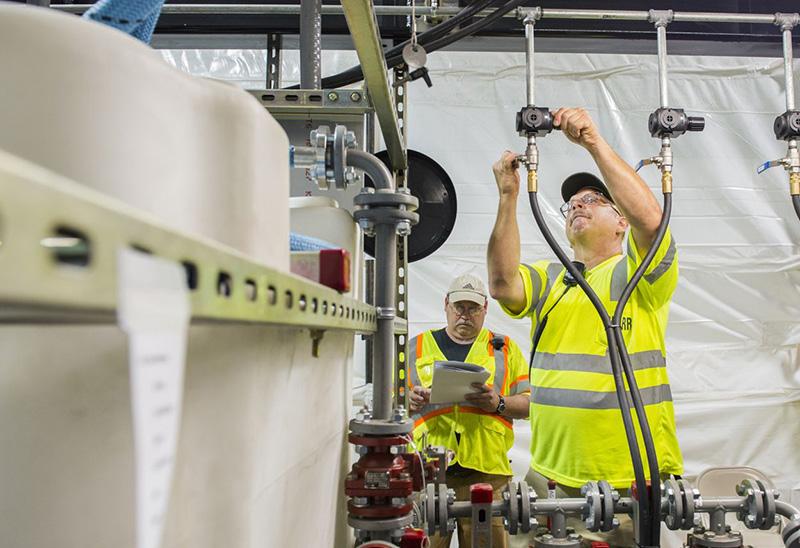
The U.S. Army Combat Capabilities Development Command Chemical Biological Center Field Deployable Hydrolysis System designers doubled up on critical valves and pumps so that the system would have no single point of failure. Here, DEVCOM CBC chemical engineering technician Doug Johnson is adjusting the air for air-operated agent pump for the FDHS. | DEVCOM CBC
containers and had to be carefully tape-wrapped. Their crew was also concerned that, while moving the containers, the valves on some of them might shear off causing a catastrophic leak. Blades visited the ship with his deputy, sized up the problems with the containers, and promptly drew up mitigation procedures for safely moving them aboard the MV Cape Ray.
Finally, at the end of June 2014, the last of the agent stockpile was loaded on trucks and sent to a port in Gioia Tauro, Italy, where the Ark Futura was docked. The MV Cape Ray arrived, and the chemical agent was carefully transferred from one ship to the other using heavy equipment.
A diagram of the fully loaded MV Cape Ray shows how the arrangement of the 200 tanks each containing 6,000 gallons of liquid required a ballet of weight distribution to minimize the threat of capsizing.
Destruction operations began on July 4, 2014. The CBARR team members worked around the clock in six-hour shifts. They did not experience any summer storms, which are common in the Mediterranean, and the seas were mostly steady at 1 to 2 feet. But it was hot, often over 100 degrees Fahrenheit.
While destruction operations were going smoothly, Blades and the ship’s engineer became aware of something ominous. The ship was staying in the rolls of waves longer than it should. The ship was becoming
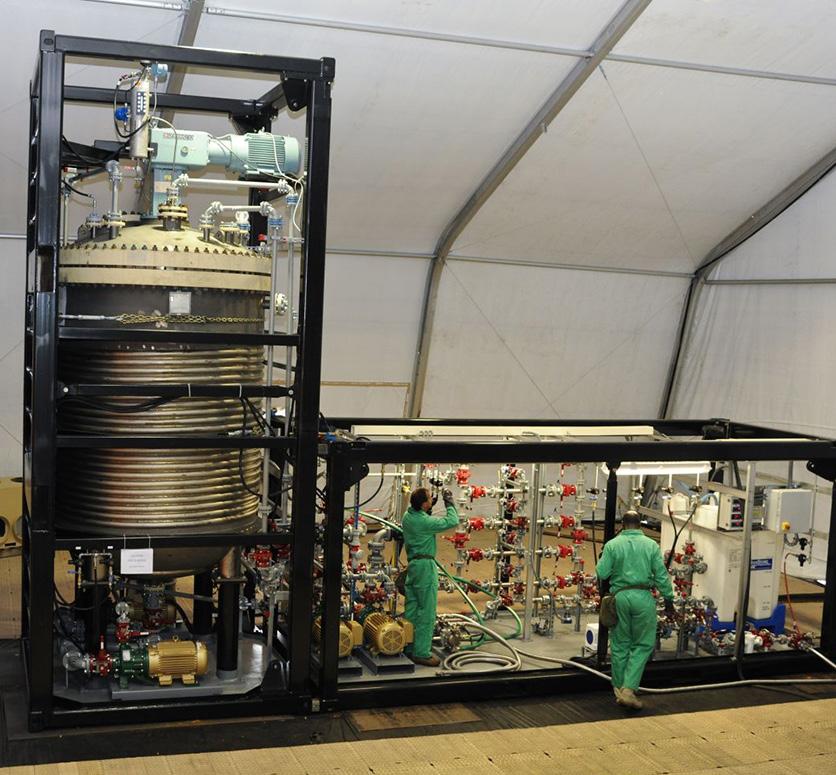
The field deployable hydrolysis system destroys chemical agent by mixing it with hot water and a caustic compound to render it a conventional industrial waste, and it is compact enough to fit into tight spaces such as the hold of a ship. |DEVCOM CBC
top-heavy. There were two reasons. First, the ship consumed fuel located low in the ship and the weight of that fuel is relied upon as ballast. As the fuel was used and the fuel tanks emptied, there was less ballast. Second, as the contents of the caustic storage tanks were moved into the mixing vessels mid-deck and the resulting hydrolysate from the reaction moved up to storage tanks on the deck, the liquid weight in the destruction process shifted up.
CBARR engineers and the ship’s engineer put their heads together and calculated that the rate of fuel consumption combined with the upward movement of liquids in the hydrolysis process gave them 39 days operations plus a few extra days to get to port to unload. According to these calculations, they would be three days short of entering the danger zone where capsizing was a real danger.
At the same time, the Italian and Greek chapters of Greenpeace, egged on by concerns of residents of Crete that an accident in the operations would harm their tourist trade, began making public statements. “We are coming,” they proclaimed, and they were assembling a flotilla of small fishing boats and yachts. While the MV Cape Ray had an international escort of warships, the CBARR crew had a job to do and did not need the aggravation. As it turned out, heavy weather
prevented the Greenpeace flotilla from getting near the operations area.
Salt sludge gums up the works
As if the problem of becoming ever more top heavy was not enough, the CBARR team was hit with another very serious problem. As the caustic neutralizing solution was mixed with the highly acidic hydrolysate, salts formed and settled on the bottom of the mixing vessels as a clay-like sludge.
It couldn’t be flushed out or scooped out, and as time went on, less and less room was available for mixing.
The CBARR team had to come up with a fix quickly as the time before the ship became subject to capsizing kept getting closer.
The solution they came up with was to bypass the mixing vessels and run hoses from the caustic storage tanks in the hold up to the deck and directly connect them with the hydrolysate storage tanks up there. CBARR team members then had to mix the hot acidic hydrolysate with the caustic compound by blowing pressurized air through a pipe. This required a kind of ship-wide ballet of maintaining stability as the liquid inside 200 tanks (each containing 6,000 gallons) moved from the hold to the deck in an ebb and flow. And all the while, the ship kept consuming fuel. On top of everything else, the ship had to be entirely self-sufficient during destruction operations. The only supplies they could get was what could fit inside a helicopter. No port in the world would allow them entry to receive supplies due to their dangerous mission. This added to their problems because the very high pH of the caustic compound continuously assaulted the entire system by eroding any material it encountered—vessel walls, hose linings, valves, pumps. Because of this difficulty with resupply, they had to use valves and pumps right up to their red zones. The ship was also running low on storage tanks at this point.
Working day and night for 42 days, overcoming every obstacle thrown at them, the team processed their last batch of agent on Aug. 17, 2014. In all, it took five months to build the FDHS, 66 days to outfit the ship, and 42 days to destroy the 1,300-ton stockpile. On Aug. 18, they dropped off the tanks carrying the hydrolysate waste at a waste processing facility in Finland.
Then they landed in Germany, where the majority of
the CBARR team took commercial flights back to Dulles Airport in Virginia. There, they were greeted as heroes by family, friends, and other members of DEVCOM CBC who had been tracking their progress.
Several team members stayed behind with the ship and spent five days thoroughly cleaning the ship. They delivered a ship cleaner than before they ever boarded it for this operation.
Later still, as they had time to recoup and take stock, several members of the project team reviewed their calculations for the capsizing danger zone and made a startling discovery. The storage containers bolted to the deck to serve as living quarters were heavier than they thought. Also, the system for measuring the volume of liquid going into the storage tanks on the deck routinely under-counted that volume. They then entered the correct numbers into their calculations and discovered that they had entered the danger zone a week before the mission ended.
Blades, looking back on the operation years later, said that in his 49 years of performing field responses all

over the world in all sorts of difficult conditions, that he had “never seen a group of people pull together, concentrate and cooperate so well in such a difficult environment and under that much pressure.”
Rachel Ponder CECOM Public Affairs
On Sept. 11, 2001, the deadliest terrorist attack in U.S. history occurred when 19 members of the extremist group al-Qaida hijacked four commercial planes, crashing them into the World Trade Center’s Twin Towers and the Pentagon. Another plane headed for the U.S. Capitol crashed in a field outside of Shanksville, Pennsylvania.
On Patriot Day, we reflect and remember the nearly 3,000 lives lost. We also honor the first responders who heroically rushed into harm’s way to save others. After 9/11, many Americans were unified and eager to find ways to help with recovery efforts and to rebuild what was destroyed. This year, on the 23rd anniversary of 9/11, we look back to see how technologies developed by the U.S. Army Communications-
Electronics Command were used during the aftermath of the terrorist attacks.
Using state-of-the-art technology to locate hazards, rebuild
Engineers with CECOM’s Research, Development and Engineering Center, then headquartered in Fort Monmouth, New Jersey, provided the world’s smallest infrared camera. The camera was attached to PVC pipe and used to search unstable piles of rubble for air pockets, or “voids,” at the World Trade Center site, commonly referred to as Ground Zero.
Army Maj. Gen. William H. Russ, then the commanding general of CECOM, discussed the command’s involvement in the rescue and recovery efforts during an interview conducted by the CECOM History Office in July 2003. Russ described the sensory capabilities provided by CECOM, including cell phone location
devices, which helped the recovery workers find people trapped under debris.
“We found almost 400 people under the rubble, but I remember it was two days later, and by that time, unfortunately, no one was found alive,” he said.
Russ said CECOM team members also brought seismic equipment to Ground Zero to help determine the stability of the rubble.
“The firefighters were going up on the rubble and all of a sudden, they would have to sound the sirens for everyone to move off because it would appear to be unstable,” he said. “Well, we found with our seismic equipment we could determine the real stability of those piles and where those problem spots were.”
CECOM also provided a laser doppler vibrometer, which was used to judge the integrity of the buildings. Additionally, hyperspectral imaging was conducted to monitor and control recovery operations from the air. Sensors used were able to geolocate hazards, including the location of fires and gas tanks buried underground.
At the Pentagon, CECOM deployed a quick reaction task force to install a communications infrastructure for more than 4,500 displaced workers. CECOM teamed with the Pentagon to execute the Phoenix Project, which was the name given to the reconstruction efforts at the Pentagon. CECOM contributed engineering and integration support to renovate the Pentagon’s command and control infrastructure.
Building partnerships
After 9/11, there was a need for increased security.
On Nov. 10, 2003, then-New Jersey Governor James E. McGreevey designated Fort Monmouth as the New
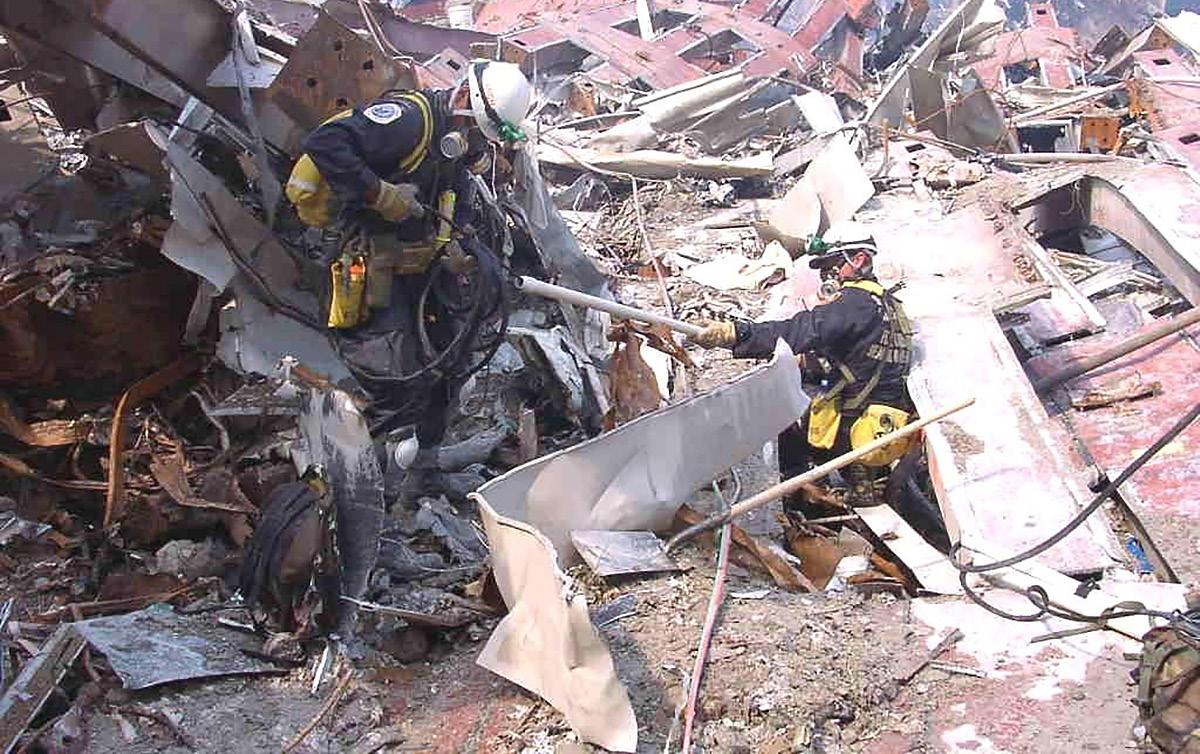
Jersey Center for Defense Technologies and Security Readiness.
“The United States will never have a shortage of brave Americans who are willing to go into harm’s way, but it has been our technological superiority that has made our Armed Forces the most advanced and superior military force in the history of warfare,” McGreevey said. “Much of today’s modern weaponry depends upon software and electronics developed and supported at Fort Monmouth.”
In an end-of-tour interview conducted by the CECOM History Office on June 24, 2004, Russ noted the effective teamwork demonstrated after 9/11.
“Increasing the teamwork has allowed our community to have a greater effect in terms of supporting New York City and the Pentagon after they had that terrible terrorist attack on 9/11,” he said. “The teamwork between our community, as well as with industry, I think, was significant.”
Susan Thompson CECOM History Office
Today, most people look at their phones to see what the weather will be. That ability relies on more than 150 years of Signal Corps research and development. A breakthrough in forecasting was the development of satellite monitoring.
Television and Infra-Red Observation Satellite launched on April 1, 1960, by an Air Force vehicle,
to televise cloud formations within a belt several thousand miles wide around the earth and transmit a series of pictures back to special ground stations. This first television-type satellite for worldwide cloud cover mapping was produced under Signal Corps technical supervision and NASA sponsorship. Its two TV cameras—one a wide-angle lens photographing 800-mile squares of the earth’s surface and the other shooting 30-mile squares— ranging between the latitudes of Montreal and
New Zealand, were of different resolution for direct readout and tape storage. This represented the most intricate control so far used in a satellite.
The first orbit pictures were rushed to Washington on a new facsimile machine, also developed by the Signal Corps Research and Development Laboratory. It transmitted a high-quality picture to its destination in just four minutes. As a result, the first pictures from TIROS were on the U.S. president’s desk shortly after they were received from the satellite, and he personally released the information to the world.
During its three months of operation, TIROS sent down more than 22,952 pictures of cloud formations, depicting the world as man had never seen it. Although it was only an experimental forerunner, TIROS I made important discoveries and contributions to meteorological research.
The use of satellite technology for forecasting reflected almost a century of Signal Corps interest in meteorology and weather prediction. After the Feb. 6, 1870 law directing the War Department to take meteorological observations and share them around the country using telegraph, the Chief Signal Officer was assigned the responsibility on March 15, 1870.
Eventually establishing daily weather maps for the nation, and publishing the Daily Weather Bulletin, Weekly Weather Chronicle, and the Monthly Weather Review, the Signal Corps created a means for conveying important information for agriculture and industry around the country. This led to a major telegraph-line construction effort by the Signal Corps beginning in 1873. The Signal Corps would continue these duties for 20 years, until the establishment of the National Weather Bureau under the Department of Agriculture in 1890.
World War I brought a resurgence of interest and responsibility for meteorology to the Signal Corps, and a Meteorological Section was established in 1917. Commanders needed the information to support anti-aircraft and long-range artillery, aviation, sound ranging to detect enemy artillery, and general operational planning. The use of gas warfare also required knowledge of wind currents and velocity.
The Signal Corps had to recruit experts from outside the Army to meet their needs, and one individual, William R. Blair, received a commission as a major
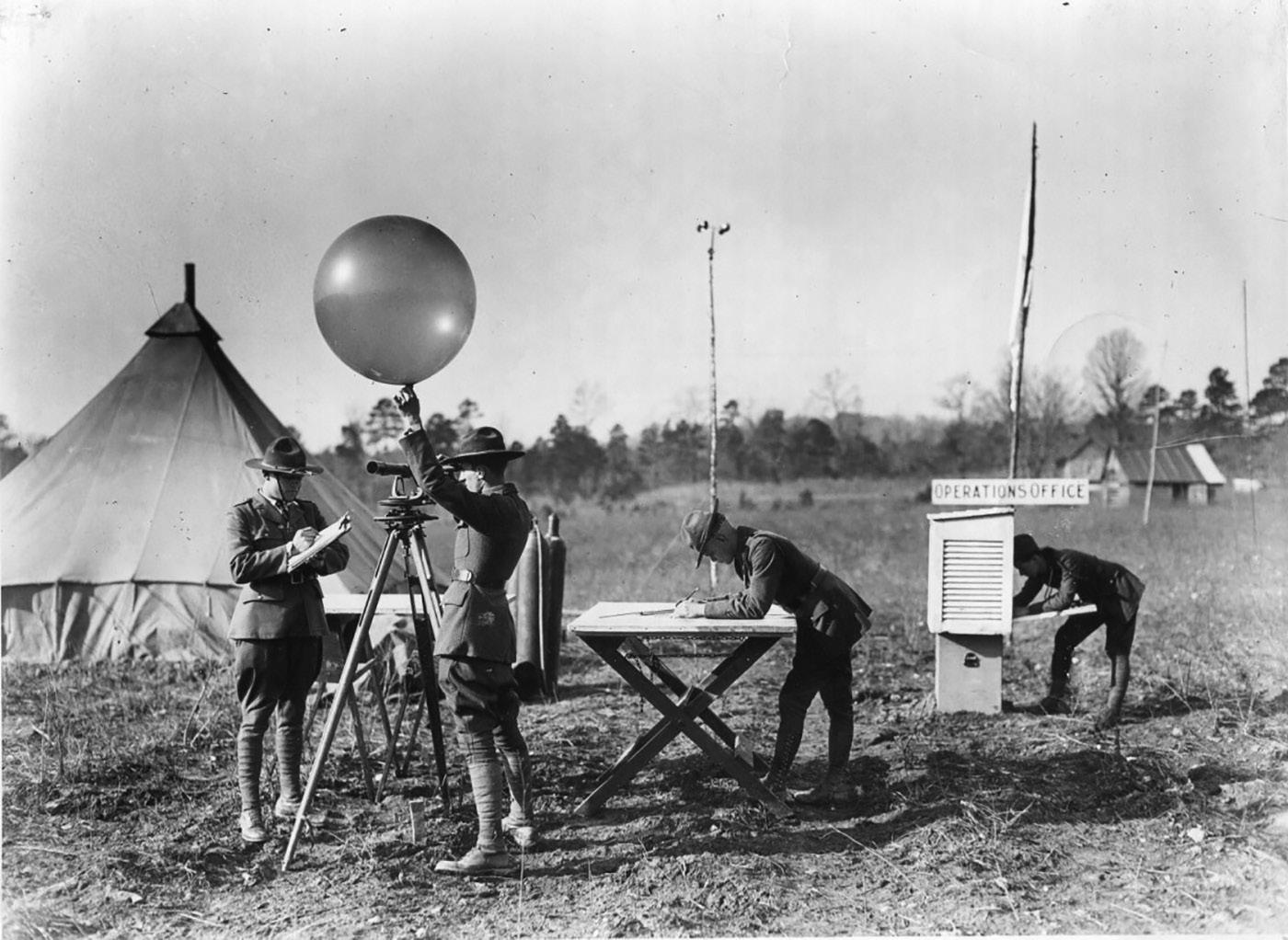
in the Signal Corps’ Officers Reserve Corps and became the chief of the Meteorological Service in the American Expeditionary Forces. Blair was appointed as the director of the laboratories at Fort Monmouth in 1930 and drew on his background in meteorological forecasting and experimenting in sound ranging to help develop the pulse-echo method of location, becoming the “Father of Army Radar.”
The Signal Corps’ interest in meteorological programs would continue to support Army aviation programs and communications, conducting research in the Meteorological Division of the laboratories at Fort Monmouth throughout the mid20th Century. Project Cirrus worked at attempting to control the weather with cloud-seeding experiments, and the labs were using radar to track storms in the 1940s.
The Signal Corps also developed an electronic computer that would determine high-altitude weather conditions and perform the calculations necessary for a forecast.
The Signal Corps also conducted climatological studies around the world, including research teams in Antarctica and the North Pole. The next time you know to bring an umbrella, think of the years of Signal Corps research behind the forecast.
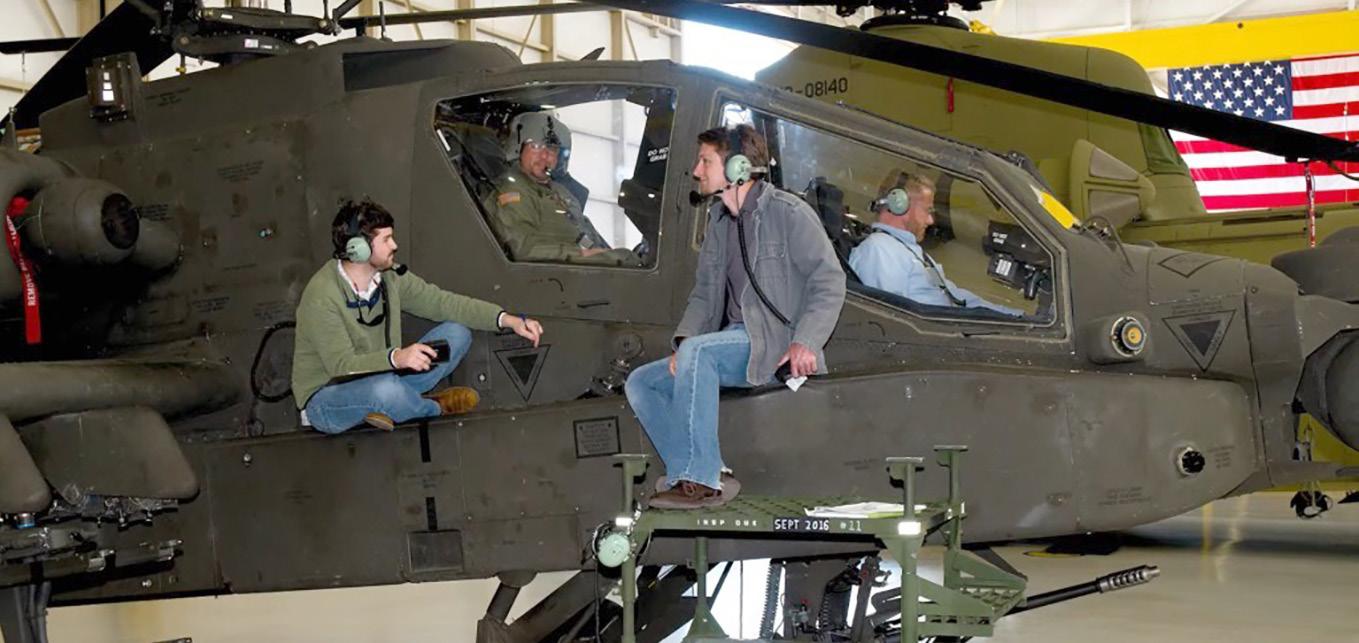
Maj. Lucas Gebhart
ATEC
Blaine Perry
U.S. Army Redstone Test Center
In 2015, the scourge of ISIS swept Syria and the western deserts of Iraq, tearing apart the hard-fought gains from years of Americans fighting in Iraq. The resulting operational environment was confusing and dangerous, with myriad factions of friendly and enemy forces in a nonlinear battlefield complete with widely dispersed high-level threats. Not since the opening days of Operation Iraqi Freedom, before the development of the Common Missile Warning System, had Army aviation encountered such a nonpermissive threat environment. Air defense artillery assets—like 57 mm anti-aircraft cannons and the high-rise building structure of Mosul—drove rotary-wing aviation to increased altitudes, while other threats with questionable CMWS effectiveness drove the need to remain low level.
Given the currently fielded aircraft survivability equipment on many rotary-wing airframes, the threat environment was not conducive for safe and effective deployment of the AH-64 aircraft that the
Iraqi army so desperately needed to defeat ISIS. U.S. Army aviators needed access to a new aircraft survivability equipment capability. This unforeseen requirement drove a Joint Urgent Operational Needs Statement for fielding of a new critical capability, requiring the expertise of the testing and evaluation professionals at U.S. Army Test and Evaluation Command to conduct a thorough but expedited evaluation. Plan and execute
ATEC, in direct support of Army Futures Command, is expected to plan and execute rigorous testing of the systems the Army intends to field, gather large amounts of data from those systems, reduce that data into meaningful insights, and share the findings with senior leaders. Generally, these tests can span multiple years of effort and thousands of hours of labor from the test community over various iterations of testing and data analysis.
JUONS efforts are unique. Though ATEC is still required to plan and execute testing and gather data for reduction into insights, the needs of the community demand that this process be condensed to months versus years. This urgency typically requires 18hour days and seven-day weeks. Teams would start
their days at 4 a.m., plan, brief, and fly several sorties, planned flights with specific routes and data collection objectives, and hope to begin data reduction at 5 p.m.
One line of testing, known as bias and jitter, characterizes the performance of a pointer-tracker on the aircraft in terms of operating power and laser movement on target. It is complex, involving thousands of frames of infrared imagery, aircraft time-space-position information, video processing, and data sizes and complexity exceeding the processing capability of ATEC’s tool set.
To make things more difficult, mission requirements dictated testing at multiple test sites across the U.S., most often in areas with limited or no connectivity, meaning that data delivery involved shipping hard drives back and forth across the country. Not only could ATEC not conduct timely processing of data, but it also took weeks to get the data to analysts and evaluators, resulting in months from test event to informed decision. At a time when the Army and ATEC needed an efficient observe, orient, decide, act, loop, legacy systems failed the evaluators doing everything they could to get capability to the field.
To reduce this cycle and meet the needs of the Army, ATEC needed a more efficient means to transport data to analysts; better systems, tools, and processes for analysts to work with data sets rapidly growing in size and complexity; and more efficient methods to serve evaluations and insights to the acquisition community.
As ATEC struggled through the JUONS cycle, 4-6 Heavy Attack Reconnaissance Squadron, 16th Combat Aviation Brigade was finalizing a movement from Fort Carson, Colorado, to Joint Base Lewis-McChord, Washington, having deferred many long-term and time-intensive maintenance tasks until after the move.
Not yet slated for deployment, but imbued with a healthy dose of paranoia, one of the authors, thenCapt. Lucas Gebhart, developed a plan to bring the organization back to a healthy deployable state by synchronizing two to three years of maintenance with a busy training schedule in a 12-month period.
Over the course of that year, 4-6 HARS would accomplish that maintenance, learn of, prepare for, and initiate deployment to Iraq and learn of, train on, and field the JUONS requirement. This was disruptive to the unit’s deployment training plan, requiring tens of hands-on hours per airframe over weeks of downtime per airframe in addition to the already robust maintenance requirements in a unit trying to train and deploy to Iraq.
More importantly, from the perspective of the observing aviators, they were giving up a security blanket with over a decade of proven results, the CMWS, in exchange for a system that seemed buggy, hastily fielded, and with which they flew precisely zero hours prior to taking off for the first time in a highly contested environment. In addition to the training and maintenance disruptions from JUONS installation, fielding disrupted block leave afforded to Soldiers pending a yearlong rotation to Iraq.
In early 2022, recognizing the shortcomings of its data analysis and delivery capability, ATEC hired a chief data officer, with the mandate to digitally transform the way that ATEC conducts the core of its mission. Bringing together a group of experts, and leveraging environment and technical assistance from U.S. Army Futures Command, ATEC set out to design and implement the ATEC Data Mesh. A data mesh collates data along logical business lines, while maintaining access control at the data owner level, leveraging robust governance and cataloguing to enable federated search across the full data corpus. By November 2023, ATEC brought the data mesh from ideation to authority to operate, the core requirement for use of an information system in the DOD, allowing ATEC to onboard its user base and begin to transform data use across the command.
The ATEC Data Mesh seeks to resolve both technical and bureaucratic hurdles to efficient operational conduct, with the ATEC Cloud Enablement Team providing the infrastructure, technical support, funding, and managed services to the entirety of ATEC. The construction includes continuous integration and continuous deployment pipelines to emulate a robust commercial environment within the security required by DOD. Taking the “Field of Dreams” approach, designing and delivering world-class capability for any interested party in ATEC, the cloud team built and deployed data domains encapsulated in ATEC’s authority to operate for each of ATEC’s subordinate elements.
After onboarding, users will find a robust set of database servers like SQL, SMI, Mongo, PostGres; data analytics tools Databricks, Synapse, Function Apps; and an Azure Virtual Desktop pool, a virtualized computer infrastructure, complete with the software tools that ATEC’s professionals use on a day-to-day basis like Python, R, JMP, and MatLab. The cloud team’s objective is to enable any analyst, any data, anywhere.
The core of the ATEC Data Mesh is the common reference model, an application program interface infrastructure that seeks to link to root authoritative sources of data throughout the Army, while exposing the root authoritative data for test and evaluation. The CRM will enable reuse of this root data in applications and software within ATEC and the Army, allowing developers to form applications without risk of the underlying data becoming stale or incorrect. ATEC’s portion of the CRM is the ATEC Enterprise Framework, a systems modeling language model of the entire ATEC enterprise, its capabilities and its business processes. Expanding on this work, ATEC is building an evaluation framework that seeks to standardize measures of performance and effectiveness used to evaluate a system’s performance against the root requirements document—the source of truth for what constitutes “passing the test.”
In the end, the CRM, the ATEC Evaluation Framework and the ATEC Data Mesh will enable ATEC to digitally link an acquisitions program all the way from the requirements document to the test data and evaluation of each requirement. With all the test data for a program residing in their common home in the ATEC Data Mesh, digitally linked via the CRM, ATEC can drastically improve both the efficiency and effectiveness of ATEC’s test and evaluation mission.
In less than two years since ideation, ATEC developed and deployed a capability to its workforce and finds itself in the nascency of adoption. While there is much to do in terms of executing the vision of the future outlined above, the ATEC Data Mesh is currently capable of executing its any analyst, any data, anywhere mission.
Because of the ATEC Data Mesh, the ATEC of today and tomorrow is no longer restricted to the systems and processes that have inhibited our ability to deliver capability at the pace of need. In the past, because of the timing and locations of testing, we struggled to access the computing resources or data storage that we required. Today, we have the full capability of a Microsoft Azure cloud environment and have worked to bring together teams of government and commercial technical experts to revolutionize the way that ATEC does business.
To highlight those capabilities and show the ATEC community that very complex problems can be solved using the new tools available, ATEC’s chief data
officers initiated several data pilots, including development on the bias and jitter problem. U.S. Army Redstone Test Center created an application in the ATEC Data Mesh that would automatically ingest raw video files, locate the laser on the target board and calculate its position error. In the past, each two-hour sortie required an average of 10 hours to curate files, trim video, and extract information—a process that analysts could not start until the data arrived.
Over the course of the JUONS effort, ATEC completed dozens of sorties. Today, after three weeks of effort by RTC’s data scientists, a user can load an entire sortie’s video data directly to the ATEC Data Mesh from the field site via our data upload utility HERMES. The application will automatically identify files, conduct bias and jitter processing, and produce results in minutes. Importantly, that data can be shared with all ATEC’s partners instantly from anywhere as soon as the automated processing is complete. The ATEC Data Mesh can decrease the turn time of the bias and jitter testing from months to hours. Relevant, timely information to senior Army leaders is a core part of achieving ATEC’s mission. The ATEC Data Mesh has redefined these terms, enabling us to provide more relevant data at speeds that were never possible.
This is not the end for the ATEC Data Mesh: ATEC’s data is a weapon and a force multiplier. In the case of the JUONS, just one additional month to view the JUONS test data and to ask questions would have meant so much to the confidence of a Soldier being sent into harm’s way, entrusting their lives in a system with which they have never flown. Extending this problem set to weapons and munitions, master gunners and technical experts in formations would make use of trustworthy and accessible data to expand the lethality of their fighting formations.
Conclusion
The future of warfare relies more heavily on data than ever before. Artificial intelligence, machine learning, and more, all require enormous amounts of high-quality data—the kind of data that the ATEC community produces today. In the past, Gebhart would not have had access to this data, but with the ATEC Data Mesh, he can. In turn, ATEC can make this data descriptive, predictive, and prescriptive, telling Soldiers not just what happened in a test, but describing what might happen in other environments, and how to gain an advantage by using the systems to their maximum extent. By reducing its OODA loop, ATEC can enable Soldiers in the field to reduce theirs.
Rachel Ponder CECOM Public Affairs
As athletes from around the world gathered in Paris this past summer for the Olympic Games, we took a look back in history to see how the U.S. Army CommunicationsElectronics Command’s predecessor organization, the Communications and Electronics Materiel Readiness Command, played a role in ensuring security during the 1980 Winter Games, held from Feb. 13-24, in Lake Placid, New York.
The 1980 Lake Placid Games took place during the Cold War, which increased the need for heightened security measures. Just before the 1980 games, in December 1979, the Soviet Union invaded Afghanistan, which resulted in a call for an international boycott of the 1980 Summer Games in Moscow by U.S. President Jimmy Carter.
The terrorist attacks at the 1972 Munich Summer Games were also fresh in the minds of the international community, adding to the already tense environment surrounding the games in Lake Placid. Palestinian terrorists broke into the Olympic Village, killing two members of the Israeli team and taking nine hostages. All the Israeli hostages were killed, as were five of the terrorists and one policeman.
In an overall effort to keep the crowds safe during the Lake Placid Games, employees from Fort Monmouth, New Jersey, worked with the New York State Police and the FBI to install a sensor system, the Remotely Monitored Battlefield Sensor System, around the perimeter of the Lake Placid 1980 Winter Olympics.
REMBASS, which was in its early stages, was a hightech intelligence system developed to provide military commanders with information about hostile activity. These unattended ground sensors could detect movement of potential targets, including people and vehicles. According to a report submitted to Congress in 1981, REMBASS performed reliably and effectively under heavy military traffic, high speeds, and severe weather.

REMBASS proved to be an asset in non-military environments to prevent unauthorized intrusions.
“Earlier versions [of REMBASS] were used during the 1980 Winter Olympics to guard the competitors and functioned successfully even under eight feet of snow,” stated a report published in April 1998 by Forecast International, a company that provides market research for many defense projects.
The report also stated that REMBASS pre-production units were also successfully used during the U.S. invasion of Grenada in 1983, part of the Cold War. In addition to the U.S. military, the U.S. Border Patrol deployed REMBASS units along stretches of the U.S.-Mexico border.
Production for REMBASS ended in 1988 due to technological advancements in battlefield surveillance. Currently, more than 10,500 athletes from around the world competed during the 2024 Summer Olympic and Paralympic Games in Paris, France. A total of five Soldiers from the U.S. Army World Class Athlete Program were selected for Team USA.


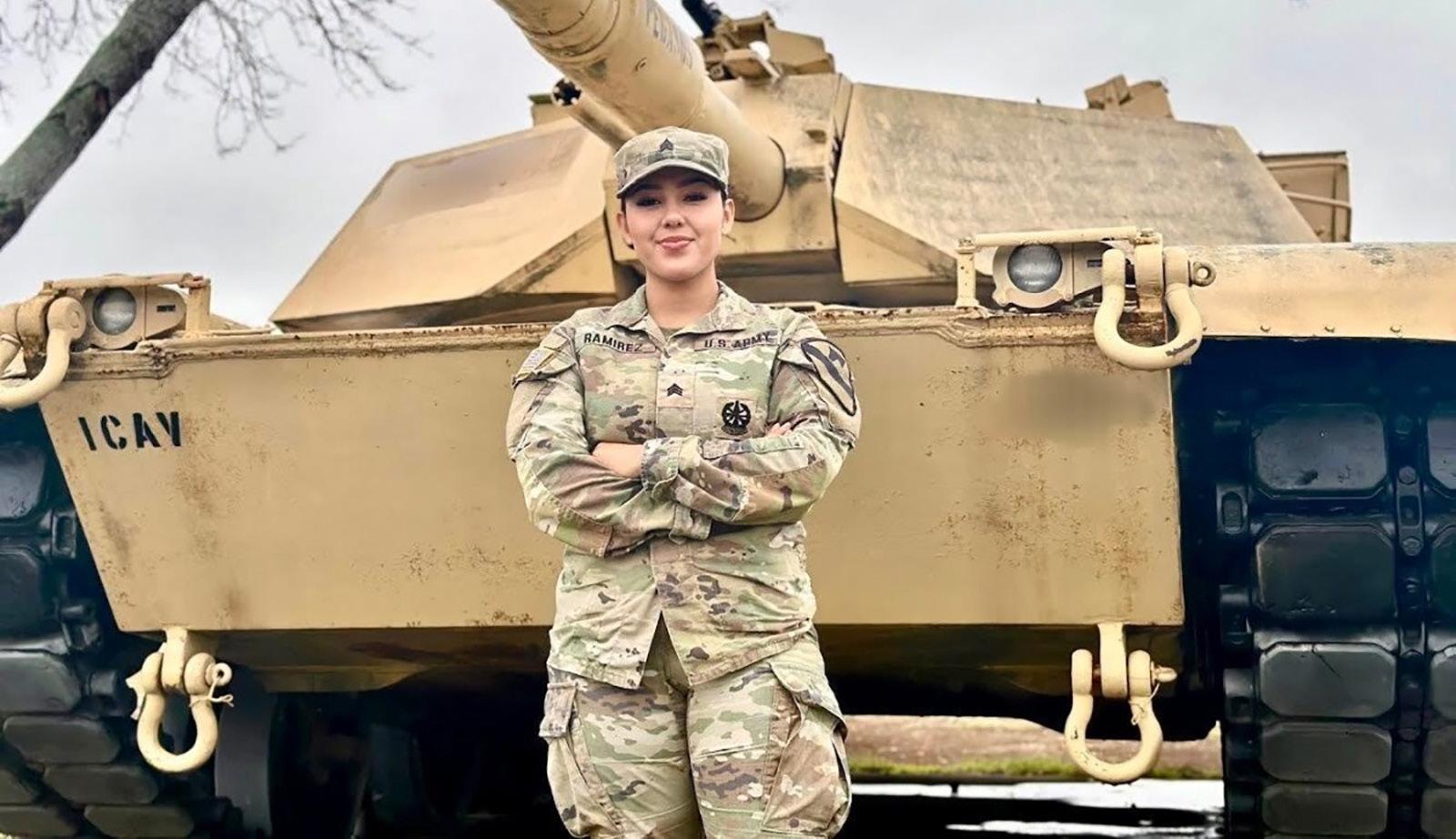
Maya Green CECOM Public Affairs
The U.S. is a nation steeped in rich history. Its citizens reflect a wide range of backgrounds, cultures, and ideals. This diversity continues to shape the nation, and for the Armed Forces often forges more cohesive teams. The Army is one of the most diverse organizations in the country. Every Soldier’s story, like thread built into fabric, is woven into the Army’s identity, creating a more ready force.
Hispanic Heritage Month, annually observed from Sept. 15 to Oct. 15, provides the platform to nationally recognize the achievements and contributions of Hispanic Americans, to both the Army and the nation. This specific time frame also reflects the independence anniversaries of Costa Rica, El Salvador, Guatemala, Honduras, Nicaragua, Mexico, Chile, and Spain.
Since the Revolutionary War, Hispanic Americans have fought for this country, and alongside the men on the front lines were women who would set the foundation for future generations of service members.
Technician 4th Grade Carmen Contreras-Bozak was one of the first Puerto Rican women to join the Women’s Army Corps. She served as an interpreter and was able to speak English, Spanish, Portuguese, Italian, and French. In 1943, Bozak was one of the 195 women who made up the first cadre of women sent overseas. She arrived in North Africa and was assigned to the Signal Corps, sending and receiving coded messages between Gen. Dwight D. Eisenhower’s headquarters in Algiers and the battlefield in Tunisia.
Pfc. Carmen Garcia Rosado is also one of the first Puerto Rican women to join WAC. She was an educator, author, and activist for female veterans. Rosado wrote “LAS WACS-Participation de la Mujer Boricua en la Segunda Guerra Mundial,” the first book to document the experiences of the initial 200 Puerto Rican women who served in the U.S. Armed Forces during World War II.
In the late 1970s, Col. (Retired) Maritza Sáenz Ryan was accepted into West Point as a member of the third class that included female cadets. Ryan graduated from West Point in 1982 and was later commissioned as a second lieutenant in Field Artillery. She returned to West Point as a U.S. Military Academy Department of Law professor, eventually becoming the head of the law department in 2006. Ryan is the first woman and first Hispanic American West Point department head.
Brig. Gen. Irene Zoppi Rodríguez became the first Puerto Rican woman to be promoted to the rank of brigadier general in the U.S. Army Reserve in 2017. Beginning her military career in 1985, Rodríguez has served as deputy commanding general for the U.S. Army South and as the director of the Army Reserve Engagement Cell for Individual Mobilization Augmentees. As a civilian, she serves as a program
director for the National Intelligence University under the National Security Agency. Rodríguez has also served as a member of the Maryland State Board of Education, specializing in assisting military families and minority students.
Staff Sgt. Ariana Sanchez is one of the nine enlisted women to graduate from the Army’s Sapper School. The Sapper Leader Course became available to women in 1999. Sanchez immigrated to New Jersey from Ecuador at 17 and joined the Army to challenge herself. She earned her Air Assault Badge from Fort Liberty in 2017, before going on to graduate from SLC in 2019. Of the nine enlisted women to graduate, Sanchez is the only one to become an instructor.
In Fort Cavasos, Texas, M1 Armor Crewmember Staff Sgt. Cinthia Ramirez became the first Hispanic American woman to earn the title of master gunner. Ramirez graduated from the M1A2 Abrams Master Gunner Course in 2022. To earn the Master Gunner Identification Badge, a Soldier takes one of eight master gunner courses, such as infantry, aviation, or field artillery. Master gunners serve a critical role for a mechanized or armor unit, advising commanders and taking part in the planning, development, execution, and evaluation of all combat and gunneryrelated training.
Ryan Rayno DEVCOM Public Affairs
“Both of my parents were computer programmers, so I was exposed to computer science from a young age,” said David Arty, a branch chief for the U.S. Army Combat Capabilities Development Command’s Command, Control, Communications, Computers, Cyber, Intelligence, Surveillance and Reconnaissance Center. “I became interested in learning the process of putting things together and making them do interesting new things.”
Arty’s parents started bringing computers home in
the late 1980s, allowing him to experiment with early generation machines at a time much earlier than others in his neighborhood.
“This was the time of luggable computers, and we were one of the first houses to have computers to tinker with,” he said. “Once friends of mine started getting computers in the early 2000s, I was able to show them things that I had learned over time.”
After graduating high school, Arty earned his Bachelor of Arts in Computer Science and Chemistry from Cornell University and a Master of Science in Software Engineering from Monmouth University.
“Right after I graduated from Cornell, I started at Monmouth and came into a group there that was learning cybersecurity,” he said. “I didn’t have any significant cybersecurity schooling, but I was able to learn it with the help of my CS background. I decided to stay in the cybersecurity field because it’s an interesting and constantly changing area.”
Arty was able to leverage his interest in computer science and cybersecurity into a new career at DEVCOM C5ISR Center, then known as the Communications-Electronics Research Development and Engineering Center, in 2004.
Working at DEVCOM C5ISR Center has given Arty the ability to work with emerging technologies and equipment much earlier than others, just like he had the opportunity to do growing up.
“As a science and technology organization, we are able to see what’s being developed in real time and how cyber affects it all,” Arty said. “From very early in my career, I was able to test computer systems that were in ground vehicles and test systems software going into aircraft. It’s allowed me to put real-world context and perspective in supporting Soldiers, and that’s been very rewarding.”
Arty also credits DEVCOM C5ISR Center for the opportunity to continue his professional growth throughout his now 20-year career.
“Training and education are encouraged and easily approved in terms of learning specific domain knowledge and having the constant ability to see new topics,” he said. “I started my career working on risk management, which focused on security on platforms and networks, but I’ve had the opportunity to add software assurance, which is working on applications that are running on platforms and networks. It’s been really interesting.”
Those opportunities to work with new technologies while expanding his expertise is what equips Arty to best combat real-time advancements from threats.

“Threats continue to evolve and the techniques and technologies that we encounter are going to continue to grow,” Arty said. “Some of these ways will be unpredictable, and we will need to continue to learn how to use new tools; DEVCOM C5ISR Center has been very helpful to me with that in terms of helping with cybersecurity certifications to augment my computer science background.”
Just as he’s appreciated the support in his selfdevelopment, he’s been especially happy to see that support extended to his team for their development as well.
“To see everybody learn how to use new tools themselves and support new systems has been very rewarding to see,” he said. “They grow professionally and help the branch grow as they advance in their careers. We’ll see a lot of new emerging things that bring very interesting ideas in the next decade or so because our leadership makes it really easy to get what we need.”
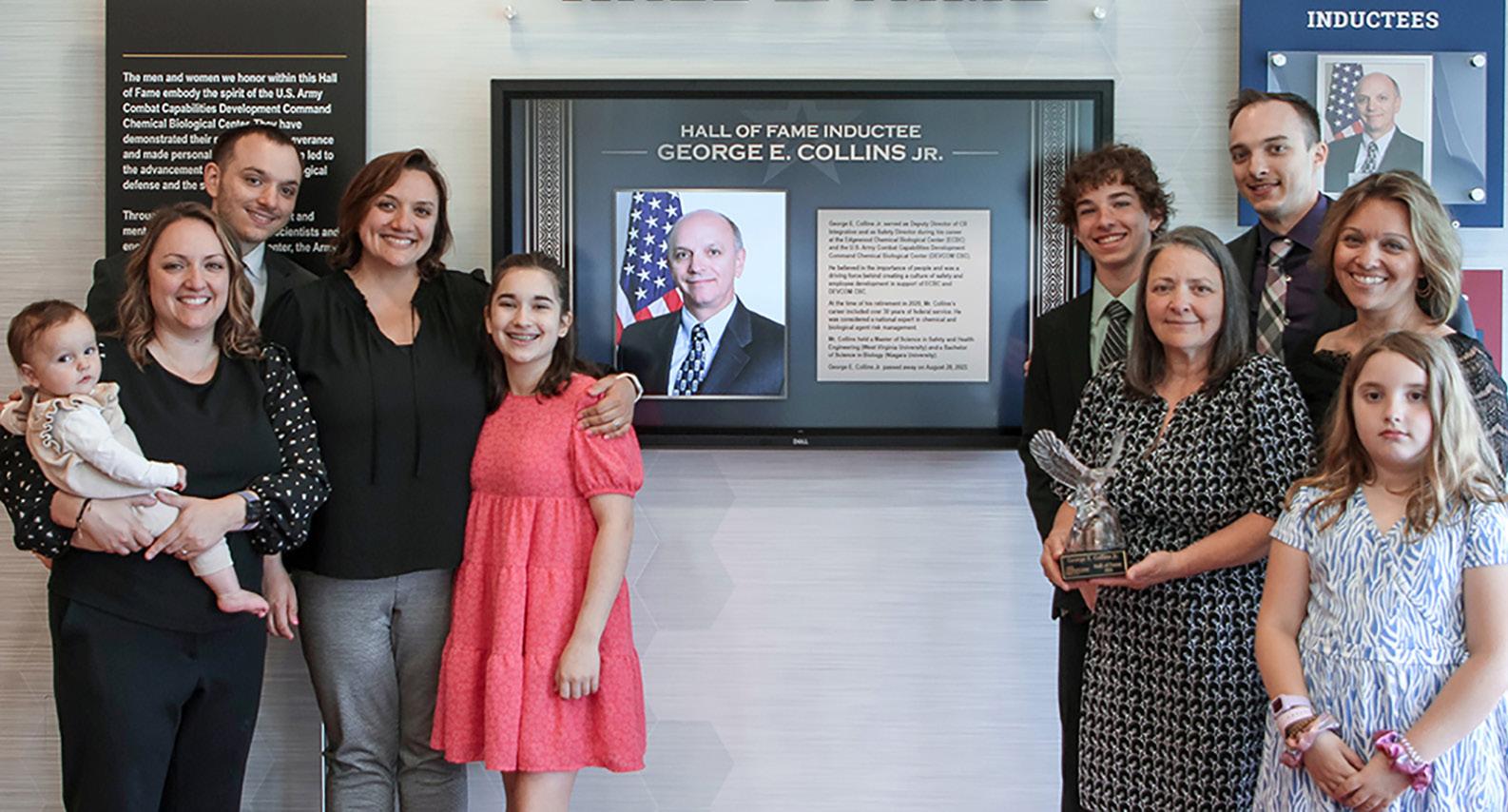
Parker Martin DEVCOM CBC Public Affairs
The U.S. Army Combat Capabilities Development Command Chemical Biological Center honored its 2024 inductees to the DEVCOM CBC’s Hall of Fame in two separate ceremonies this year.
During the most recent ceremony in August, James Michael “Mike” Cress, former liaison officer at DEVCOM CBC, was inducted. This ceremony followed the induction in May of the late George Collins, DEVCOM CBC’s former director of safety. Both individuals made monumental contributions to the command’s mission of developing and delivering capabilities to the warfighter.
During Collins’ induction in May, several of his former coworkers shared stories about how he dedicated his life to fostering a work culture
and attitude centered on improved safety. His policies, which emphasized protocols for chemical repositories, hazardous waste storage, personal protection, and chemical agent monitoring for local and international customers, were instrumental in protecting lives.
“He cared about people; that’s why he was in safety and human resources,” said Joseph Wienand, former director of DEVCOM CBC, or Edgewood Chemical Biological Center as it was known at the time. “He was patient, too. Whenever he’d offer nuggets of wisdom, he’d say, ‘Have you considered…’ and that’s when you’d pay attention. He just loved all the people here.”
Collins held dual leadership duties for DEVCOM CBC as the deputy director of chemical biological integration and director of safety. His chemical
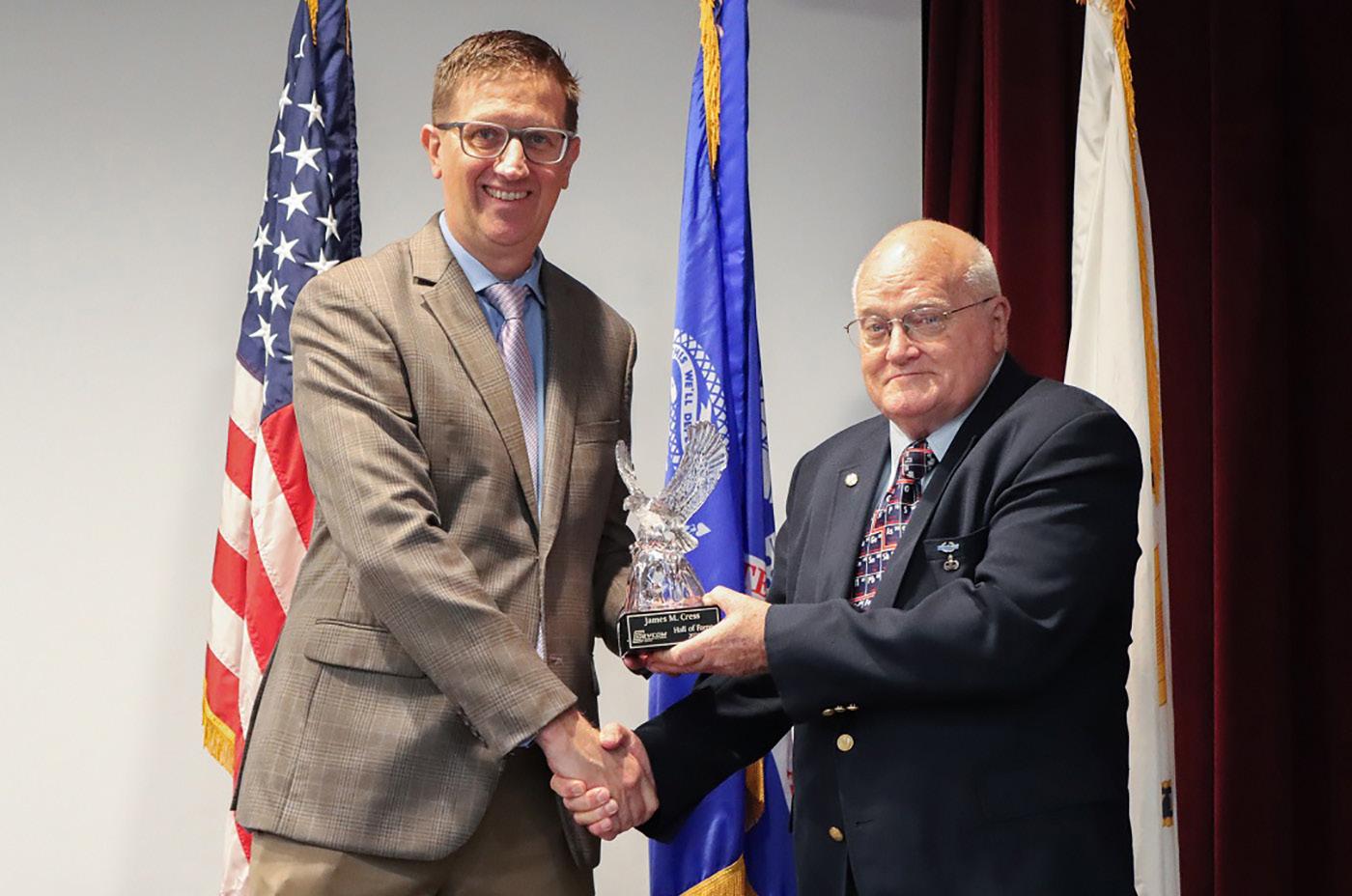
and biological risk management expertise was invaluable for the Army, DOD, and the nation.
“He was simply the gold standard—he made deliberate decisions and recognizable influences on everyone he met,” said Nancy Carter, DEVCOM CBC’s chief operating officer and former mentee of Collins. “He taught and cared for absolutely everyone.”
In the most recent induction ceremony honoring Mike Cress, members of the workforce shared their thoughts and reflections on how, for nearly 50 years, Cress was a positive influence, spurring innovation and providing leadership to the chemical, biological, radiological, and nuclear enterprise and DEVCOM CBC.
Cress, a lifelong contributor to DEVCOM CBC and the nation’s successes, joined the Army in 1966,
serving two tours in Vietnam with the 101st Airborne Division and as an instructor at the U.S. Army Infantry School. After retiring with the rank of lieutenant colonel, he continued his passion for lifelong learning and educating others by becoming a trusted expert in tactical CBRN operations, shaping future strategies of the CBRN warfighter through his role as a liaison officer. Cress was a key contributor to the Chemical Reconnaissance, Explosive Screening System program. He holds multiple patents and won the 2022 Maj. Gen. Harold J. Greene Acquisition Writing Competition. Though he retired in 2021, Cress continues to serve the organization as a part-time annuitant, working with DEVCOM CBC’s Engineering Directorate on strategic initiatives and new projects.
A number of former colleagues spoke on Cress’
behalf, including Dr. Eric Moore, former DEVCOM CBC director; DEVCOM CBC Scientists Dr. James Jensen and Janet Jensen; DEVCOM CBC Deputy Director of Engineering Lowry Brooks; and DEVCOM CBC Liaison Officer David Glynn.
“I am entirely confident that five minutes is not enough time even to come close to describing Mike’s impact over the decades he has dedicated to our Nation, and I’m proud to call him my close friend,” said Glynn, Cress’ protégé before his retirement. “I cannot emphasize the profound leadership and mentorship that Mike has provided to those he has come into contact with throughout his career.”
Following these remarks, Cress joined DEVCOM CBC Director Michael Bailey onstage for his awards and official induction before taking the podium himself to thank all those who impacted his career and reflect on what it means to support the warfighter.
“You don’t get where you are today without overwhelming support from your family,” said Cress. “A big aspect of this job is learning. We have a huge technical library here, and that extends to the people. The many wonderful researchers I’ve worked with over the years were eager to share their knowledge. Those bits and pieces made my career what it was.”
Collins and Cress join Dr. Jim Baker and Dr. Harry Salem (both inducted in 2018), and William “Bill” Klein (2022) as members of the DEVCOM CBC Hall of Fame.
“This organization, in one form or another, has been here for over 100 years,” Bailey said during the August Hall of Fame induction ceremony. “It’s safe to say that there have been tens of thousands of people who have passed through these doors. Out of that massive pool, only four have been inducted into our Hall of Fame. Today, we add our fifth.”
Ryan Rayno DEVCOM Public Affairs
Foteini Argiropoulos, Ph.D., a software assurance lead for U.S. Army Combat Capabilities Development Command’s Command, Control, Communications, Computers, Cyber, Intelligence, Surveillance and Reconnaissance Center did not take a typical path to get to where she is now.
Originally from Corfu, Greece, Argiropoulos did not start postsecondary schooling until she was 32 and living in the United States.
“Once my two daughters started preschool and kindergarten, I started going to community college,” Argiropoulos said. “The first course that
I took was marketing, and a part of that class discussed computer science and information technology. I thought, this is the field that I’m actually interested in.”
From that single marketing class at community college, Argiropoulos has checked every education box there is.
“It’s funny to me sometimes because I didn’t know if I would be able to keep continuing after each step,” she said. “Life was always getting in the way it seemed, so I just set one goal at a time: first I’ll get an associates of science degree; after the associate’s degree I’ll get a Bachelor of Science in Computer Information Systems; after a bachelor’s degree I’ll get a Master of Science in Information
Systems; and after a master’s degree I’ll get a doctorate in Information Systems.”
Through that long journey, Argiropoulos has found a profound gratitude for not only the educational opportunities, but the doors those opportunities opened.
“I feel lucky to be employed by the [DOD] and by DEVCOM C5ISR,” she said. “I am extremely grateful, because not only was I not born in the U.S., but I also started my career at an older age. Despite that, I know I’m trusted to do the work and because of that, I’m able to thrive in my field, so I couldn’t be more grateful and thankful for the work I’m doing here.”
Argiropoulos credits her husband and team for supporting her while she pursued her education, including her doctorate while working at DEVCOM C5ISR, but credits her leadership for supporting her through her innovation efforts.
“The great thing about working here is that I have the freedom to bring new technologies or ideas to our team,” she said. “I’m given the go ahead to see if we can implement any work-related innovation into our research processes to make them more efficient. I get to work on the kinds of things that really excite me and I’m extremely happy to work with the people that I do.”
Argiropoulos primarily works on machine learning and how it can be utilized to help warfighters win on the battlefield.
“I think machine learning will become more and more engaged in our daily activities and lives, and while we have to be very careful with it and ensure that we have checks on it, I fully embrace it,” she said. “I’m very excited for what the future brings because I think that the advancements will be something that we are not able to imagine right now. It’s going to help us continue to reduce the risk of harm to our Soldiers, and it’s going to help

Soldiers carry out their mission more effectively. That is the number one priority and that is what we work for.”
While Argiropoulos is grateful for the support from her family and coworkers, and grateful for the opportunities that support has led to, there is one other thing she primarily feels regarding her professional career: pride.
“I am extremely proud of my organization and how it helps its employees achieve their goals,” she said. “I’m proud of our mission, and I’m proud of the team that I work with.”
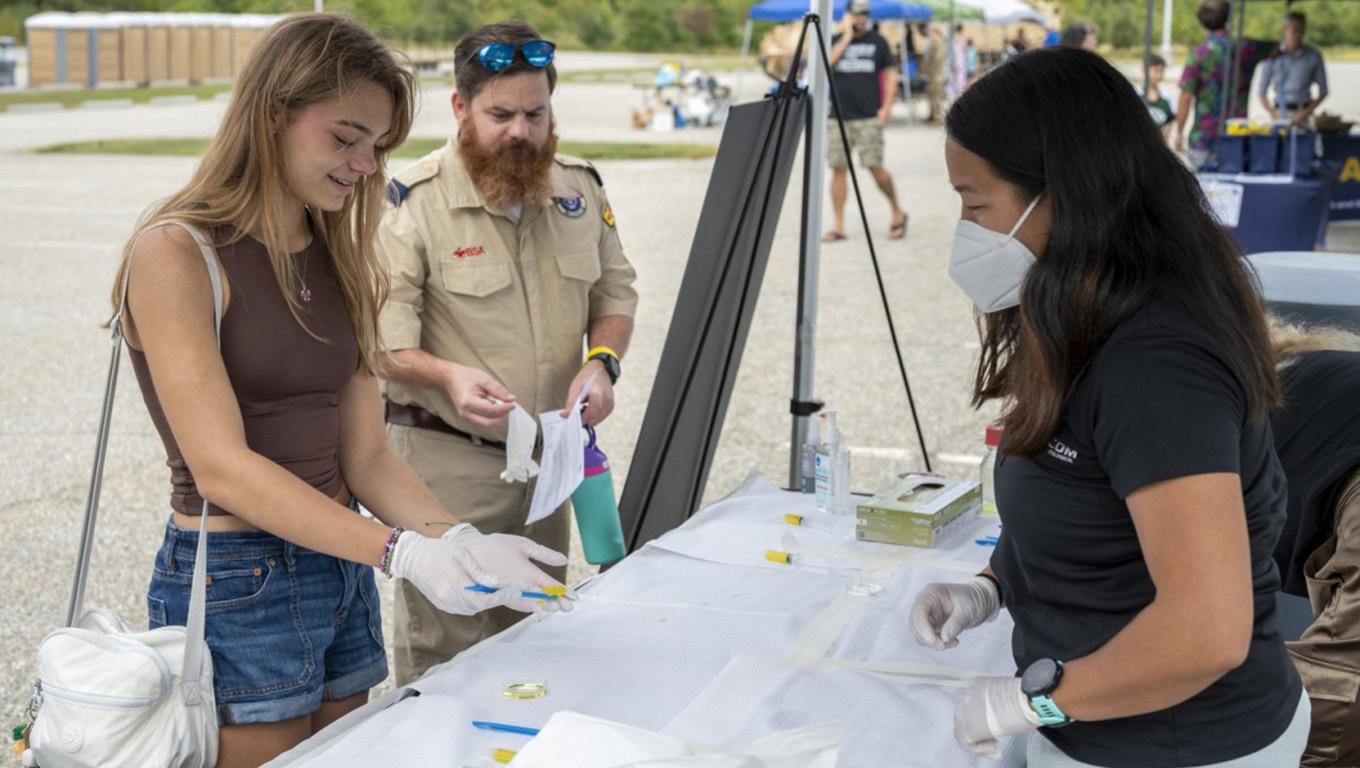
Ryan Rayno
DEVCOM Public Affairs
The U.S. Army Combat Capabilities Development Command’s Command, Control, Communications, Computers, Cyber, Intelligence, Surveillance and Reconnaissance Center held Aberdeen Proving Ground STEM Day Sept. 21, 2024, at APG, Maryland.
DEVCOM Chemical Biological Center; U.S. Army Test and Evaluation Command; U.S. Army Aberdeen Test Center; Defense Centers for Public Health – Aberdeen; APG Morale, Welfare, and Recreation; and Discovery Center at Water’s Edge participated alongside the various DEVCOM C5ISR directorates.
“Events like this give us the chance to talk to our students, our college students, and get them excited about science, technology, engineering, and math, and making STEM something that everyone is engaged
in,” Erica Bertoli, an outreach lead for DEVCOM C5ISR Center, said. “As a whole, APG is part of the Harford County community, so it’s important for us to open the doors when we can and invite our neighbors to see what we’re doing, to peek behind the fence so to speak, and help them become a part of our community as well as help us become a part of theirs.”
The event had more than 20 stations to get visitors excited about STEM fields and learn how each organization contributes not just to the technological capabilities of the DOD, but to communities worldwide.
“This is a great way to get our name out there, get known, and show people that the work we do not just at APG, but at DEVCOM CBC, has vocations for the technologies that have uses in medical care, material science, and things that are used by the average consumer every day,” said Casey Weininger, a STEM

different
program manager for DEVCOM CBC. “It’s an opportunity to show that things we do here have an impact on everyday life.”
The various stations had demonstrations and opportunities for hands-on-experience for all ages across a variety of STEM fields including night vision and thermal imaging, cybersecurity, 3D printing capabilities, and robotics among others.
“I had a lot of fun learning about the different equipment and programs here,” said Alannah Belcher, a student at Bel Air High School. “My favorite ones were testing the night vision goggles, trying to block hacking attacks, and making chemical worms.”
In addition to getting students excited about STEM fields, the event also allowed the organizations to show that career opportunities exist outside of typical pathways.
Ken Johnson, a physicist with DEVCOM C5ISR Center, brought two robot dogs to the event, allowing visitors to practice controlling them while navigating an obstacle, as well as to share the opportunities in a robotics career at DEVCOM C5ISR Center.
“Our goal is to inspire the next generation of engineers and scientists to work with the Army,” he said. “When I was in school, everyone wanted to work for NASA and big known companies, but I’m sure if they knew this was an option, they would be jumping at this great opportunity. We want them to know that their talents, hard work, and

to the mission of the different organizations on the installation and inspire excitement for the STEM fields.
passion will not only grow and be respected at DEVCOM but will go on to support the strength and longevity of America for centuries to come.”
APG STEM Day welcomed more than 1,000 visitors over the course of the day, but for Bertoli, she would like to see even more next year to further spread the importance of APG and its tenant organizations and to strengthen community relationships.
“My hope is that the visitors go home, tell their friends, and come back next year with five more people,” she said. “I hope that the work being done by our engineers, our Soldiers, our subject matter experts on this installation is shared throughout the community. However, for me, really the biggest win is when people leave here and feel that APG is part of their community.”


Rebecca Wright Army AL&T and ASC
The U.S. Army is known for protecting our nation predominantly on land. But as our adversaries’ capabilities advance, so must the Army’s ability to predict, counter, and, if necessary, defeat them. Focusing mainly on proficiency in one or two domains can limit the Army’s ability to advance in support of the joint force. Potential adversarial threats—primarily posed by, but not limited to, China and Russia—call for the Army, as part of the joint force, to continuously transform to operate in all domains on a future battlefield. This means not only having specialized experience on the ground, but across all domains holistically.
In December 2018, the Army published “The U.S. Army in Multi-Domain Operations 2028,” which outlines the importance of maintaining a position of superiority and how to win future conflicts.
“Multidomain operations are the combined arms employment of joint and Army capabilities to create and exploit relative advantages that achieve objectives, defeat enemy forces and consolidate gains on behalf of joint force commanders,” the U.S. Army’s Field Manual 3-0 states. “Employing Army and joint capabilities makes use of all available combat power from each domain to accomplish missions at least cost.”
In essence, multidomain operations are an effort that the Army, as part of the joint force, is undertaking to expand frontline operations and expertise across all domains and synchronize them across an interconnected and uncertain operating environment.
For the U.S. and its allies to maintain dominance, warfighters must remain ready to engage across the competition continuum. Current Army doctrine identifies five key areas covered in multidomain operations: land, air, maritime, space, and cyberspace. Potential adversaries are challenging these areas and competing for dominance across the multidomain environment. Space and cyberspace operations have not always been at the forefront within the Army, but are becoming increasingly important.
“There are specific departments of the DOD that

are our specialists in those areas: the Air Force, the Navy, cyber, and even Space Force,” said Col. Rashad Fulcher, senior simulations officer with the U.S. Army Operational Test Command. “In order to fully round out a true MDO [multidomain operations] environment, I think that we absolutely need to conduct joint testing or at least have joint representation in our operational testing. It’s important to the Army because of our current and future threats. As we see world events in current conflicts, people are targeting electronic signals. The electronic environment is a concern for us, and we need to be ahead of that threat.”
For example, in a potential combat scenario the Army will secure terrain with armored vehicles and ground forces while coordinating with Air Force-operated fighter jets and Navy-operated ships, all while using space satellites to track and monitor the location of the threats and using cyberspace communications to exploit and disrupt the enemy’s technology.
While stressing the importance of multidomain operations is easy, experimenting, testing, and training to operate in a multidomain environment is a different story. It comes as no surprise that live, physical testing, and training is costly and potentially hazardous. In October 2023, to address the Army’s need to prepare
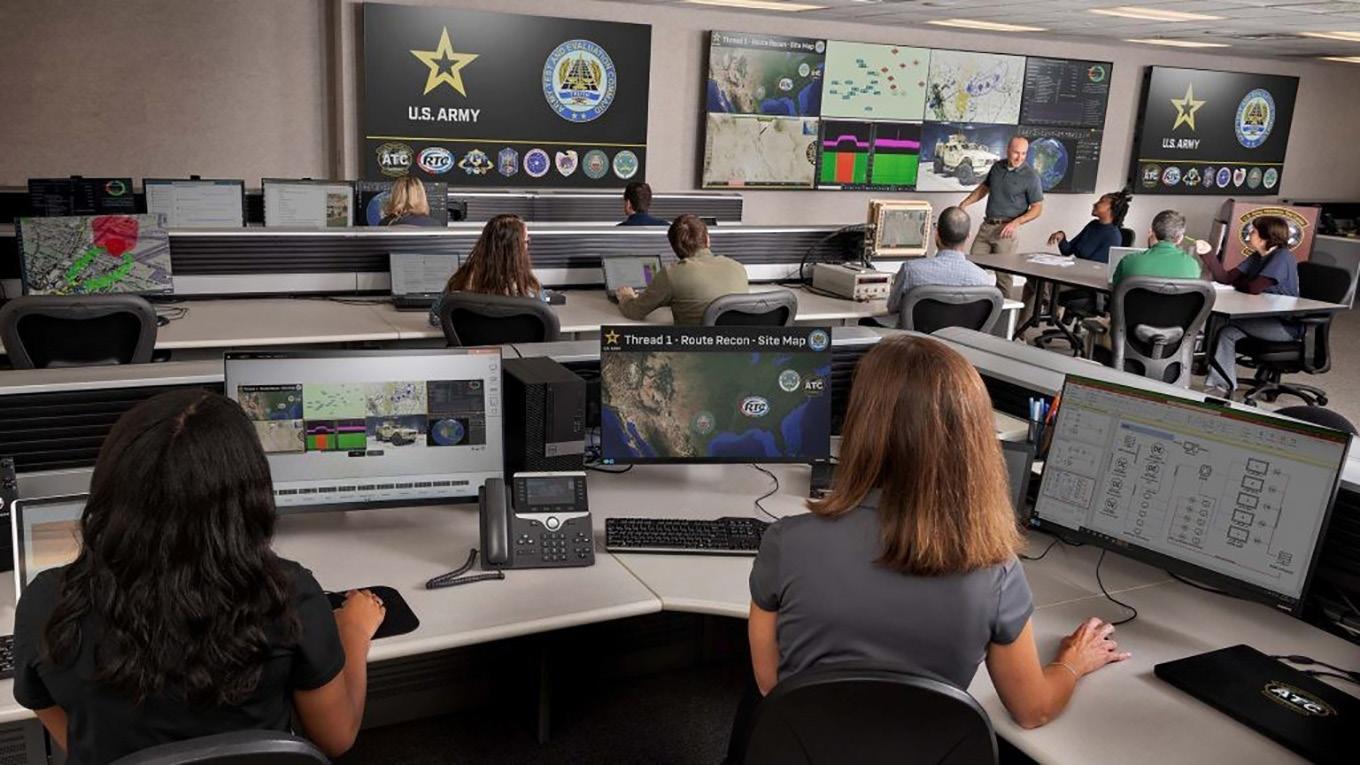
for future dominance, the U.S. Army Test and Evaluation Command conducted multidomain operations in a test environment that included live, virtual, and constructive simulations. The demonstration, conducted in Maryland at Aberdeen Proving Ground, networked capabilities from all eight ATEC locations throughout the U.S. to successfully test operational scenarios in the land, air, space, and cyberspace domains. In addition to testing, the LVC environment can enable experimentation and training opportunities that are not only realistic but allow testing of systems, concepts, formations, and forms of maneuver that would otherwise be too costly or impractical to perform in a live environment.
“We created an operationally relevant learning environment by connecting a number of test facilities from across the country through an innovative test network provided by the Test Resource Management Center,” said Paul Weimer, a supervisory engineer at the U.S. Army Aberdeen Test Center, a subordinate of ATEC. “To achieve the scale commensurate of an MDO environment, the physical test capabilities were integrated and synchronized with virtual systems using the LVC construct.”
Weimer explained that the LVC environment enables experimentation with new scenarios that could not be tested and evaluated in live-only or virtual-only settings. These scenarios test the user and the materiel solutions in real time and provide additional data that enables users to be better prepared if a similar scenario occurs in a tactical environment.
“In order to get to an operational level of scale, we need to supplement the live assets with virtual assets in a way that the user is unable to tell whether the system is
live or virtual,” he said. “The systems in the LVC environment respond in the same manner as the systems in the real-world environment, which allows us to build up the scale of the experiment, test, or exercise. Using LVC, we’re now getting after an operationally realistic, scaled MDO environment.”
Weimer described one of the threads demonstrated at the October 2023 event. A live, fielded tactical vehicle was placed in an electromagnetic interference chamber, a controlled environment used to test radio frequency emissions, susceptibilities, and interference. While in the chamber, the tactical vehicle was secured to a dynamometer, a device that measures torque and engine power and enables a vehicle to operate in different driving conditions.
During the demonstration, an operator used throttle and steering input inside the vehicle to drive while it was secured to the dynamometer. In a feedback loop, the vehicle’s steering and engine output were measured on the dynamometer and returned to the simulated test environment, changing the simulation output. The live tactical vehicle could be seen moving in the simulated scene and the movement drove changes with live or virtual threats or entities in the simulation.
“In this thread we demonstrated an electronic warfare attack on the vehicle to see how it would impact the convoy,” Weimer said. “Using a live jammer in the EMI chamber, we jammed the tactical vehicle’s fielded GPS and radio systems. Then, you could see in the simulation where the live vehicle lost contact with the simulated convoy. The live vehicle was no longer visible on the tactical screens and the operator driving the system lost situational awareness of their position.”
“The objective of the test was to measure the time for the operator to regain situational awareness and communication with the convoy,” Weimer continued. “I think it is important to be able to see the effect of a threat beyond just the effect on an individual system. In traditional developmental testing, my focus would just be the effects on the live system in the chamber, but with the LVC environment we were able to see the effects on the live vehicle and how that effect impacted the overall tactical operation. We can now learn the broader impacts of that electronic warfare attack on the entire formation and operation.”
Operating as a joint force within the military is nothing new, but doing it seamlessly, in all domains, is a new
challenge. ATEC’s ability to simultaneously test with both live and virtual assets while providing real-time data and results gives the Army a leading edge in experimentation, training, and testing.
“We’ve always been able to do live testing, virtual [only] testing, and use simulations to provide some results or some statistics for single systems, but the most powerful thing about LVC is the increased scale of the test environment and the ability to measure the interactions and interoperability of systems,” Weimer said. “Now we can have Soldiers that are included in this environment communicating with these assets and see how they respond when another member of the formation is hit with an electronic warfare attack. We can see how the formation responds in an operationally relevant environment and use that information to inform material system improvements, leader development, training, tactics, and procedures.”
Weimer added that the LVC environment is capable of rapidly adjusting to new parameters and scenarios. Focus areas that are tested today will change tomorrow and organizations will require different training conditions. The LVC test environment can be tailored based on specific user needs and requirements.
“So, the environment is built for the application,” he said.
To date, the environment has only been tested among Army users. ATEC is working to coordinate with users
from other branches of the military to engage in the LVC test environment. Traditionally, each branch of the military operates independently and works within the fields that they specialize in. And while that tradition may remain in place for the most part, to achieve the leading edge in providing desired effects across all domains requires increased collaboration across the joint force.
“MDO is inherently a joint environment,” Fulcher said. “I really think it’s the future of testing and the future of how the American force—and not just the ground force but the joint force—will be conducting operations.”
In an environment that is always changing, the Army is transforming its test and evaluation capabilities to stay abreast of its multidomain operations initiative. ATEC’s LVC test environment provides a new way of testing, collecting instantaneous results, and providing a new pathway to test in real time. The LVC environment can produce a multitude of different scenarios to better prepare users for future operations.
By identifying and improving upon our weaknesses, enhancing response time and collaborating across all frontline environments with joint forces, the Army can better prepare itself for operational challenges against potential adversaries and achieve multidomain dominance.
Bridget Lynch ACC-APG Public Affairs
Agile is defined as the ability to move quickly and easily, and it is one of the buzzwords heard around the globe as the Army continues to modernize. Commanders must be agile in multiple ways. Physically—to shoot, move, and defend over their adversaries; and mentally—to learn, understand, and lead their troops. To be agile is a critical quality you want to find in a Soldier, but what about in technology?
In today’s digital era, technology is changing at warp speed, and we depend on it to function. For our Soldiers, technology can make all the difference on the battlefield. Ensuring they are equipped with the right hardware and software is critical to maintaining a competitive advantage over our adversaries.
Through the creation of the Digital Capabilities Contracting Center of Excellence at Army Contracting Command – Aberdeen Proving Ground, the Army is engaging earlier in the capabilities process by examining initial requirements and reimagining

contracting processes that account for software success.
Take, for example, the routine software updates that are installed on a cell phone. There is always another version available, another bug needing to be fixed. In a perfect world, they are as easy as a click of a button, but if the physical equipment cannot support the software installation, you are left with a piece of hardware that is essentially obsolete.
Hardware and software are equal players in warfighting, and having the right combination will enable commanders to defeat their enemies in the information environment just as effectively as in physical combat.
“The DC3oE will help us reimagine how we do contracts for software capabilities and making it a standard way of doing business,” said Danielle Moyer, ACC-APG executive director and senior contracting official. “We must change our thought
process to create contracts that are agile in nature, and with the right aligned incentives and disincentives.”
Under this Army-wide directive, the DC3oE is responsible for new contracts and select existing contracts for software capabilities executed by Program Executive Office Enterprise; PEO Intelligence, Electronic Warfare & Sensors; PEO Command, Control, and Communications – Tactical; and PEO Simulation, Training, and Instrumentation; as well as select contracts for the Army Commands, Army Service Component Commands, and Direct Reporting Units.
Since its official designation by the Secretary of the Army in March of 2024, and achieving Initial Operating Capability in June, the DC3oE continues to make significant progress in enhancing software contracting processes across the Army by turning its focus to building expertise among contracting officers and training to familiarize them with Digital Transformation concepts.
There are several initiatives in place to upskill the workforce through education, such as leveraging the “Digital Foundations” courses, created by the Director for Army Career Management, and developing a workshop on Contracting for Modern Software Development in coordination with Defense Acquisition University.
Additionally, the development of several playbooks, covering modular contracting, contract structure, and source selection and evaluation, will assist in the development and execution of contracting strategies, requests for information, requests for proposal, contracts, and agreements.
Implementing specialized training strengthens contracting officers by teaching them to think differently when procuring software, and to consider critical components such as cybersecurity and vulnerabilities, when writing agile contract requirements. Creating this centralized expertise within the workforce ultimately enables stream-
lined and expedited timelines for contract development.
The DC3oE continues to make significant progress with mission partners towards agile and effective contract implementation. Take the contract award for the Integrated Personnel and Pay System - Army Military Payroll as an example.
This contract supports the Army’s Program Executive Office for Enterprise in developing and producing a total AMP solution with agile software development methodology for all active, reserve, and National Guard Army components, and was the first major effort the DC3oE Advisory Group provided guidance on.
Working closely alongside PEO Enterprise, the group deviated from traditional contracting methods using formal source selection procedures and added an innovative Expedited Delivery/ Enhanced Performance Contract Line Item Number, or CLIN, tied objectively to metrics to incentivize performance.
“The AMP contract takes an innovative approach to incentives that drive contract behavior to deliver quality software rapidly,” said Lt. Col. Ryan Martin, product manager for IPPS-A Increment II. “This model will be used for future IPPS-A Increment II contracts and hopefully across the Army.”
This innovative approach provided the best support to the mission partner and the warfighter, which resulted in awarding a $350 million requirement in under 180 days.
“We appreciate the DC3oE for developing a modular contracting approach that provides the Army with greater flexibility but with enough structure to incentivize great performance” said Col. Matthew Paul, PM for IPPS-A. “The AMP contract enables the Army to leverage industry’s agile best practices to
deliver new capabilities faster and in smaller increments.”
As the DC3oE evolves, there are plans to integrate industry contracting support, making collaboration and transparency with industry increasingly important. With this goal in mind, the DC3oE is already actively engaged with industry, seeking to learn and understand how to create better partnerships while also maintaining a competitive environment.
“Our team has participated in over 160 individual engagements with our industry partners on a wide range of subjects to improve how we do contracts.
We’ve hosted two Digital Advanced Planning Briefings for Industry and will continue to host similar events to maintain an open dialogue with our industry partners,” said Rob Perry, chief of strategic initiatives for ACC-APG and lead for the DC3oE advisory group.
“This communication is going to help both the Army and industry as we develop requirements and seek solutions on complex software requirements,” Perry said. “I see it as a win-win.”
The creation of the DC3oE at ACC-APG signifies a commitment to reimagining contracting processes for digital requirements. With eyes set on reaching full operating capability in December of 2024, ACC-APG continues to work with mission partners in identifying software development actions and utilizing assessments and lessons learned as it forges ahead in improving and streamlining contracting for software.
“In this age of digital transformation, it is our job to deliver the best capabilities to our Soldiers,” Moyer said. “We never want to enter a fair fight. We always want to have the advantage. Change is never easy but understanding and believing in the ‘why’ makes it all worth it.”
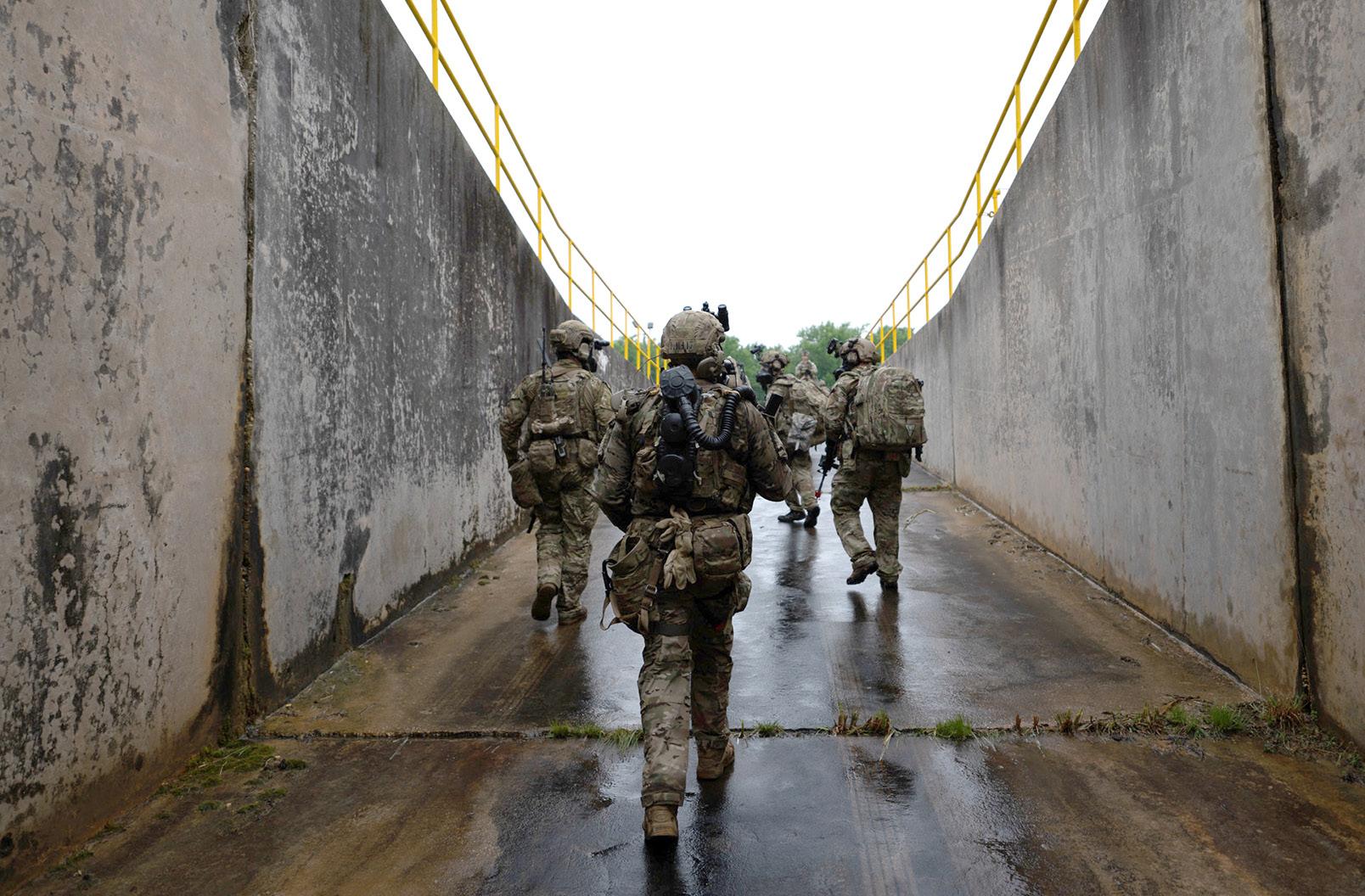
Walter T. Ham IV
20th CBRNE Command
Nuclear Disablement Team Soldiers and Army Rangers seized and exploited an underground nuclear facility during a training exercise.
Nuclear Disablement Team 1 trained with Army Rangers from the 75th Ranger Regiment during operations under simulated fire at a decommissioned pulse radiation facility, June 6.
Maj. Aaron J. Heffelfinger, the team chief for NDT 1, said the facility was an optimal training site.
“This training location challenges the force for planning, execution, and especially communications,” Heffelfinger said. “Being a former reactor site, it also has the security measures in place to make it a realistic target.”
The NDTs are part of the 20th Chemical, Biological, Radiological, Nuclear, Explosives Command, the U.S. military’s premier CBRNE formation.

NDTs directly contribute to the nation’s strategic deterrence by staying ready to exploit and disable nuclear and radiological weapons of mass destruction infrastructure and components to deny nearterm capability to adversaries.
NDTs also serve on the FBI-led National Technical Nuclear Forensics Ground Collection Task Force, which stays ready to conduct post-blast nuclear forensics.
The NDTs have previously trained with Army Rangers and Special Forces troops during combat training center rotations.
“The NDTs have been collaborating with the 75th Ranger Regiment and other Special Operations Forces to increase interoperability and interdependency across nuclear and radiological problem sets with U.S. Army Special Operations Command and
20th CBRNE Command support,” said Heffelfinger, a native of Moore Township, Pennsylvania, who previously served as an Air Defense Artillery officer.
As the U.S. military prepares to deter or defeat near-peer adversaries, Heffelfinger said having NDTs that are trained, equipped, and ready is critical for supporting conventional and Special Forces units during large-scale combat operations.
“The highlight of the exercise was the integration of the NDTs and 75th Ranger Regiment teams,” Heffelfinger said. “Both have a vested interest in radiological and nuclear issues, so being able to train together and learn each other’s tactics, techniques, and procedures provided both with additional skills. It also ensured that if we train together or respond to a real-world crisis in the future the teams are already familiar with each other’s capabilities.”

Collaboration between citizens, law enforcement, and government agencies is essential in preventing and responding to terrorism and online extremism. Together, we can build resilient communities capable of withstanding and recovering from any threat.
Sara Mastel USAG APG Antiterrorism Officer
Antiterrorism requires year-round engagement to confront the persistent threat of terrorism in the interconnected world. While leaders inside and outside the Aberdeen Proving Ground community continue the fight against terrorism, all Soldiers, Army Civilians, and contractors play a crucial role in safeguarding our communities through a shared sense of vigilance and preparedness.
The APG antiterrorism office’s top goal is the education, support, and safety of personnel working and living here. All of us can help continue the fight against terrorism.
Terrorism takes form in large-scale attacks to lone-wolf incidents, targeting public spaces, transportation systems, and everyday environments. Recognizing the signs of suspicious activity and knowing how to respond is pivotal in preventing or mitigating attacks.
Every individual action, no matter how small, contributes to our collective security.
A vigilant community is a strong defense against terrorism. Vigilance extends to the digital world, where radicalization and recruitment occur. By recognizing signs of online radicalization, such as changes in behavior or social media activity, all of us can help prevent individuals from being drawn into extremist ideologies.
Physical and digital surveillance also play a crucial role in antiterrorism efforts. APG community members can support these efforts by being observant and reporting suspicious activities through monitoring public spaces and transportation systems and tracking online activities and communications.
Operational Security is essential in protecting sensitive information that could be exploited by terrorists. Practicing OPSEC is a group effort and involves being mindful of what is shared online and in conversations, especially information related to critical infrastructure or personal details that could be used to compromise security.
Insider threats are another serious concern. Individuals with access to sensitive information or critical systems can pose significant risks if they become radicalized or act maliciously. Awareness and vigilance in identifying unusual behavior or activities among colleagues can help mitigate these threats.
Country briefs provide vital information about the security landscape of different regions, helping individuals and organizations understand specific threats and adjust their security measures accordingly. Staying informed through country briefs ensures individual awareness of potential risks when traveling or conducting business abroad,
enhancing the ability to stay safe and secure.
Antiterrorism awareness is also about building resilience. Preparedness and the ability to respond calmly in crises are crucial. Community training programs, such as active shooter drills or first aid workshops, empower us to act effectively during emergencies.
Be observant: Pay attention to your surroundings, both physical and online. Look for unusual behavior or content promoting violence or extremism.
Stay informed: Keep updated on local and global news to understand current threats. Governments and law enforcement agencies often provide resources and alerts.
Utilize country briefs: Use country briefs to stay informed about specific regional threats and adjust your security measures accordingly.
Report suspicious activity: Trust your instincts and report any suspicious behavior or online content promoting extremism to local law enforcement. Provide detailed information without direct confrontation.
Prepare and train: Participate in community safety drills and training sessions. Know evacuation routes, emergency contacts, and basic first aid.
Promote unity: Foster a sense of unity within your community. Strong social bonds can deter radicalization and promote a culture of tolerance.
Practice OPSEC: Be mindful of what you share online and in conversations to protect sensitive information.
Watch for insider threats: Stay alert to unusual behavior among colleagues that could indicate a security risk.
Support surveillance efforts: Be aware of and support surveillance measures in your community, such as security cameras and online monitoring.
Shawn Nesaw
PEO IEW&S Public Affairs
At its most basic level, maneuver is the ability to move to achieve an advantageous position. In today’s complex, multi-domain battlefield, the U.S. Army relies on a multitude of advanced systems to maneuver effectively in any operational environment.
The Program Executive Office – Intelligence, Electronic Warfare & Sensors works closely with the Maneuver Center of Excellence, and the maneuver community overall, to identify and develop new capabilities that enhance the maneuver force. This includes systems to see, navigate, disrupt, and integrate to ensure our Soldiers are better connected, more informed, and mission ready.
Looking forward
Forward-looking infrared, or FLIR, has been used by the Army since the mid-1960s to enhance targeting and surveillance capabilities. It gained prominence during the Vietnam War, being employed for night-time operations.
PEO IEW&S’ Project Manager, Terrestrial Sensors support the acquisition and development of the most advanced FLIR system to date, third generation forward-looking infrared, or 3GEN FLIR.
3GEN FLIR provides high-definition images at longer ranges under a variety of environmental conditions including fog and smoke. Enhanced sensitivity means clearer and more detailed thermal images. Higher resolution and processing gives commanders and Soldiers better, more accurate information for more accurate target recognition. Artificial intelligence and machine learning will have the ability to process these high-definition images and provide additional information to all echelons of the Army. The system is on tap to integrate on the Abrams main battle tank with additional options for integration on manned fighting vehicles.
“The 3GEN FLIR provides the U.S. Army with overmatch in the detection, recognition, and identification of enemy activity and targets,” said Lareina Adams, project manager of PM TS.
3GEN FLIR replaces its highly successful and effective predecessor—the second generation

FLIR, or 2GF. For decades, the 2GF was a gamechanger on the battlefield.
EW, and Cyber
The Terrestrial Layer System Brigade Combat Team Manpack, or TLS BCT Manpack, the current program of record for the U.S. Army’s endeavor to develop and field electromagnetic spectrum dominating electronic warfare capabilities, is a wearable pack capable of providing signals intelligence, electronic warfare, and cyber capabilities. Project Manager, Electronic Warfare & Cyber is the Army’s acquisition organization leading the effort to give mounted and dismounted Soldiers the best of breed technology in a form factor that does not impede maneuver operations.
The TLS BCT Manpack is designed for dismounted and mounted light infantry units. Its tailorable and modular design provides commanders mobile electronic warfare capabilities for any mission and in any environment. TLS BCT Manpack delivers radio frequency surveying, signals collection, and direction-finding operations as well as EMS attack and force protection all in a wearable pack.
“BCT Manpack, being a dismounted sensor, can get into more restrictive, austere terrain to sense
on enemy formations,” said Capt. Austin Knighton, assistant PM for TLS BCT Manpack.
In today’s modern operations environment, Soldiers rely on assured positioning, navigation, and timing, or APNT, capabilities to gather information about their location, teammates’ locations, terrain, and enemy locations in areas where traditional systems like GPS may be disrupted, degraded, or denied.
PEO IEW&S’ PM Positioning Navigation and Timing, or PM PNT, plays a critical role in supporting maneuver operations by providing valuable assured PNT solutions to the Army by means of dismounted assured PNT systems and mounted assured PNT systems—known as DAPS and MAPS, respectively.
PM Dismounted Assured Position, Navigation, and Timing is responsible for the development of DAPS, which provides commanders reliable alternatives to GPS when it is unavailable or degraded.
Similarly, PM Mounted Assured PNT provides reliable PNT to Soldiers integrated with Army vehicles enabling forces to shoot, move, and communicate in GPS-challenged environments via mounted assured PNT systems. MAPS devices integrated in maneuver’s mounted platforms give commanders and forces confidence in their communications, command and control, targeting and firing, intelligence systems and networks.
These PNT systems allow Soldiers freedom of movement in GPS-challenged environments. Providing Soldier-valued PNT solutions today to maneuver forces is critical to ensuring future overmatch in today’s rapidly evolving GPS-denied domains.
“Our enemies have prioritized the development of navigation warfare systems to create large GPS denial-of-service areas with the intent to disrupt maneuver, communications, fires, mission command, and ISR capabilities,” said Mike Trzeciak, project manager of PM PNT. “PM PNT is rapidly developing and fielding modernized capabilities to facilitate freedom of maneuver while providing secure timing to communications, networks, and ISR capabilities across the Army.”
As future operations will increasingly require the
ability to function without GPS, ensuring that Commanders have access to trusted, dependable, and accurate alternative PNT sources is vital for achieving mission success.
Integrated sensor architecture, or ISA, is like the USB-C cord in the world of military sensors. It is the common connection across devices. And just like USB-C, which was less common a few years ago, it has proliferated throughout most of the tech we use today. ISA is trending on a similar trajectory, aiming to connect the myriad sensor capabilities the Army utilizes to gather, analyze, and distribute data.
PEO IEW&S’ Integration Directorate leads the ISA effort, working with organizations across the Joint Force and other government organizations to make ISA the standard framework for integrating various sensors into the Army’s network-centric systems. ISA ensures all sensors can connect and talk to each other in a tactical and dynamic environment.
Working with the Program Executive Office for Command, Control, Communications, and Network, Mounted Mission Command, PEO IEW&S ISA experts are working to integrate ISA standards into all vehicles to give mounted and dismounted Soldiers a more robust intelligence picture.
“The maneuver community wants and needs a better intel picture,” said Integration Directorate Acting Director Christine Moulton. “ISA connects current systems like Army Intelligence Data Platform and the intel cloud to other systems allowing them to communicate and work for Soldiers, not against them.”
As ISA incorporates into future systems, it will allow those systems to work seamlessly with legacy systems and enables faster upgrades in capabilities by allowing individual sensors/ capabilities to be adopted more quickly to fielded systems.
PEO IEW&S also fields several other major programs that have supported the maneuver community for years: Counter RCIED Electronic Warfare / Duke; Modi Dismounted EW System; Vehicle Optics Sensor System; Long Range Advanced Scout Surveillance System; Driver’s Vision Enhancer; Boomerang Generation III; and Husky Mounted Systems.
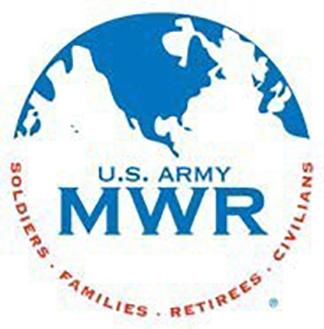
FMWR Friendly Reminder: Please Reserve/Book Your Parties/ Holiday Events/Birthday Day Celebrations!
Have your event at the APG Bowling Center Brewer Lanes/Eat Like A Greek, Top of the Bay, 1SGT BBQ located in AA Recreation Center and Ruggles Clubhouse. Book today for 2025 and 2026. Some dates are already filling up.

Strike Force Café. Parties at the APG Bowling Center! We also host office and Organization Day parties and meetings, retirement events, office team building, birthdays, church and civic groups, sports teams, and tournaments/leagues.
Call Ted Dolzine at 410-278-4794 or work cell 443-910-5937

A Beautiful Indoor & Outdoor Venue! Overlooking the Waters of Chesapeake. Please have your holiday

Whatever the event! Top of the Bay Can Accommodate. We would like to take this opportunity to thank you for considering us for your special event. Whether you are planning a birthday party for a loved one, retirement for your boss or co-worker, or celebration of your new life together as a married couple, we are prepared to offer you the highest quality food and service. Here at the Top of the Bay, we can provide you with everything from elegant sit down served dinners and delicious buffets to casual hors d’oeuvres receptions. We offer a premier conference location, wedding venue, offsite catering, banquet hall, and special events space; plus, the meeting facilities and catering capabilities that your event needs. Top of the Bay is fully equipped and ready for corporate, offsite, government, and family functions for groups. No matter the size. Our amazing catering team created their original menus for any meeting or occasion from formal plated dinners to happy hours, cocktail parties, galas, and festive parties. The extremely affordable meeting space with a beautiful waterfront location is ideal for government work functions, training, conferences, and commemorations.
Call Michael Artus-Cooper or Karen Rice at 410-278-3062/2552/5915
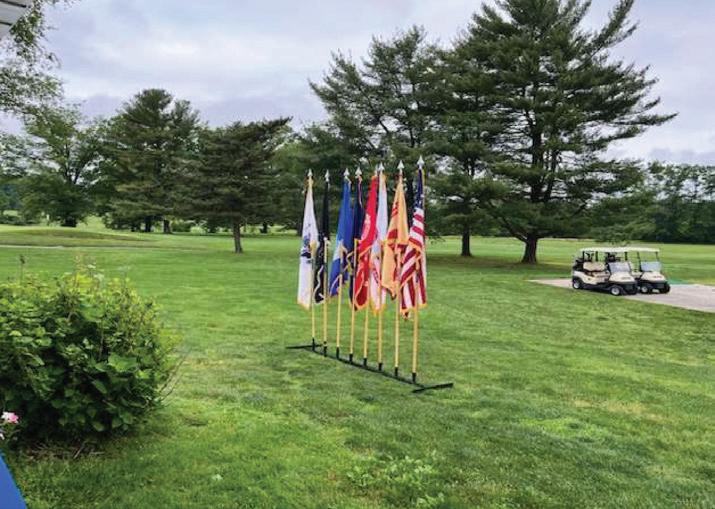


Call Ted Dolzine at 410-278-4794 or work cell 443-910-5937
Need a place to host your party? We got you covered!
Rental Fee $150 -includes cash bar when requested
Make a reservation soon!
Party platters and buffet options are available. Top of the Bay, First Sergeant’s BBQ or Bowling

First Sergeant’s BBQ

Bldg. 3326 AA Recreation Center 410-278-0534 or 443-752-4642

Maya Green, CECOM PAO
Natural phenomena are everywhere in America. These events are mystical marvels that capture the attention of everyday citizens and scientists alike. Can you solve this crossword puzzle to unravel the mysteries?
Across
8 The ,____________, or more commonly known as the Northern Lights, occurs when a coronal mass ejection, a massive burst of solar wind and magnetic fields, interacts with elements in the Earth’s atmosphere. (2 Words)
9 Thor’s ____________, or also known as the Drainpipe of the Pacific, is a large ancfaeep hole in a rock that appears to be draining the ocean. The phenomenon appears to be a bottomless sinkhole but is truly a massive hole about 20 feet deep.
10 Ice volcanoes are formed by crashing waves which ____________ in the form of magnificent cones of ice. The cones “erupt” when they shoot water up through their cores.
11 The ____________ is 277 miles long and averages 4,000 feet deep. It contains several major ecosystems, and serves as an ecological refuge to many rare, endemic, and specially protected plant and animal species. (2 Words)
13 Five species of sea turtles can be found at Padre Island National Seashore: Kemp’s Ridley, Green, Hawkbill, Leatherback, and Loggerhead. These species are all federally listed as either endangered or threatened. At release, the ____________ are set a distance from the water then crawl into the ocean. This journey is a part of the imprinting process, ensuring they remember the beach to come back and nest upon their maturity in 10 to 15 years.
16 At Yosemite National Park in California, Horsetail Fall, a small waterfall, experiences ____________. A phenomenon where the water appears to glow orange like fire when backlit by the sunset.
17 A ____________ is caused by sunlight and atmospheric conditions. Light enters a water droplet, slowing down and bending as it goes from air to denser water. The light reflects off the inside of the droplet, separating into its component wavelengths or colors. The phenomenon is created once light exits the droplet.
19 Photinus carolinus are one of at least 19 species of fireflies that live in Great Smoky Mountains National Park. They are one of only a couple species in North America who are known to ____________ their flashing light patterns.
23 The ____________ Aspen Clone originated from a single seed, and spreads by sending up new shoots from the ever-expanding root system. It is the largest, most dense organism. Scientists estimate that it is as old as the final ice age.
25 During an ____________ eclipse, the sun, moon, and Earth align but the moon’s orbit places it too far away from the Earth to entirely block the disk of the sun.
26 A ____________ is a hot spring that erupts periodically and forcibly ejects water. This phenomenon needs three things to occur: a source of heat, an abundant supply of water, and a special underground plumbing system.
27 While ____________ Falls cannot freeze, it can appear to do just that. During freezing temperatures, the waterfall’s spray and mist form a crust of ice atop the rushing water. The falls appear frozen, but the water continues to flow beneath the sheets of ice.
28____________butterflies are the only butterflies that migrate. Populations in the east take a journey that spans four generations, starting in Texas and southern states before moving further north all the way to Canada before venturing back to Mexico.
1 ____________is the production and emission of light by a living organism with little or no emission of heat. The effect is produced by energy released from chemical reactions occurring inside or ejected by the organism. A common example of this in the U.S. is a firefly.
2____________ clouds are rare, high-altitude clouds that reflect colored light after sunset and before sunrise at extremely cold temperatures.
3 Molten lava isn’t the only dangerous thing about ____________. Their ash plume is comparable to a sky filled with razorblades.The ash plume can severely damage a plane’s jet engine.
4 A ____________ is often called shooting stars. When the meteoritic material falls and is vaporized by Earth’s atmosphere, it leaves a bright trail. (2 Words)
5 ____________ causes mountains to appear as if they are on fire.
6 Hoodoo isn’t just a southern African American religious practice. Hoodoos are natural rock towers, columns, and bridges that form from cycles of freezing and thawing water. They are made up of ____________ limestone, creating angular shapes from this unique freeze-thaw cycle.
7 A wildfire or multiple wildfires in the same area can cause a firestorm. The heat from the wildfire is so strong that it creates its own wind system, and therefore weather. In some cases, the shifting air can create a ____________ tornado.
12 ____________ stones are a strange phenomenon that occur when rocks are moved by rare occurrences of rainfall that turns into ice at night and melts during the day. This weather pattern, slimy cyanobacteria that lives in the soil, and surface winds push the stones, creating their signature traces.
14 ____________ need the light from the moon to be reflected and refracted by water droplets at a precise angle to create the phenomena. They often appear white to the human eye, but long-exposure photos can reveal their colors.
15 A halo is a ring of light that forms around the sun. This occurs due to its light ____________ off ice crystals in a thin veil of cirrus clouds. The halo is typically a bright, white ring but occasionally has color.
18____________ occurs in a cloud with a negatively charged bottom and a positively charged top. The electronic fields become strong, and the atmosphere acts an an insulator between them in the cloud. When the strength of the charge overpowers the insinuating properties of the atmosphere we get this phenomenon.
19 ____________ are colored spots of light that develop because of an ice crystal’s light refraction. It is also known as “mock suns” or parhelia.
20 During a ____________ eclipse, Earth’s shadow obscures the moon. The next one is March 14, 2025.
21 Devil’s ____________ Falls is a geological puzzle. This waterfall divides into two where one river tumbles over the edge of the falls and the other half slips and seemingly disappears into a hole atop the falls.
22 During a ____________ eclipse, the moon’s shadow on Earth’s surface is about 300 miles wide. The shadow consists of two parts, the umbra, where the sun is completely blocked, and the penumbra, where the sun is partially obscured. The next one is March 29, 2025.
23 A sun ____________ appears as a shaft of light extending vertically above the sun, typically during sunrise or sundown. They occur when ice crystals slowly fall through the air, reflecting the sun’s rays.
24 This phenomenon occurs when the margin of a ____________ begins to melt, causing small caves to form between the ice and bedrock. These ice caves can also form when water exits from beneath the ____________.

All about fall
Celebrate the season with this fall-themed word scramble.
UKMPIPN ISEPC
TSVRAHE TSELVIFA
FTBLAOOL
DREAIYH
ONCR MZAE
PLEPA EIDCR
OCRCSAREW
PCRINUCOAO
LFAL GFOELIA
LNWAOHELE

ANSWER KEY:
PUMPKIN SPICE
HARVEST FESTIVAL
FOOTBALL
HAYRIDE
CORN MAZE





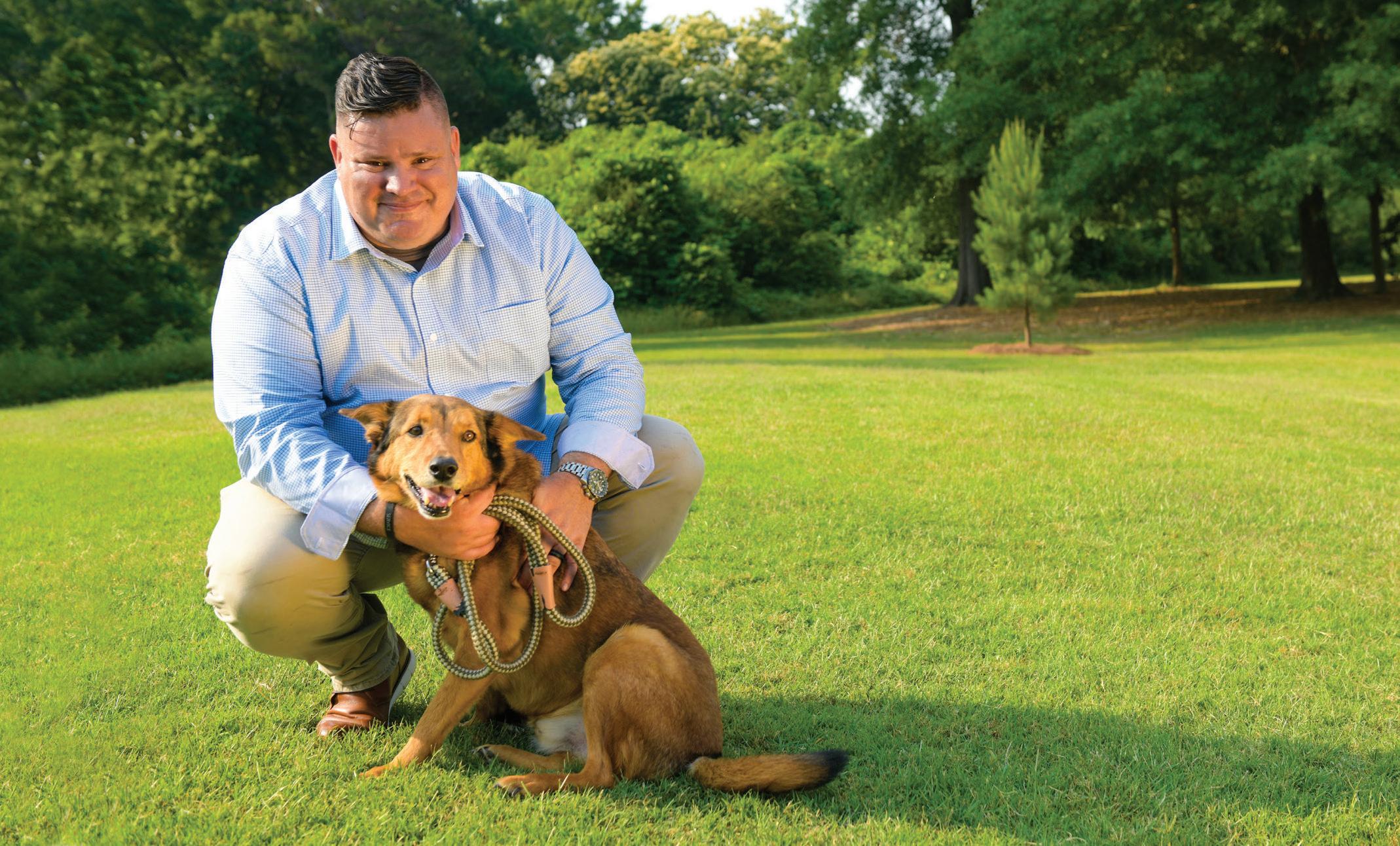
After U.S. Army veteran Jake Norotsky’s deployment to Iraq, his post-traumatic stress (PTSD) was so severe he considered suicide. After he registered for Wounded Warrior Project® (WWP), he realized that other veterans shared similar experiences and that he was not alone. Today, Jake has a new mission: to connect with audiences around the nation by sharing his story.
When you pledge your Combined Federal Campaign donation to WWP, you will help provide injured veterans and their families access to life-changing programs and services to help them reach their highest ambition.
Visit GiveCFC.org or scan the QR code to make your pledge today.






